Catalytic Support And Uses Thereof
O'HARE; Dermot ; et al.
U.S. patent application number 16/098984 was filed with the patent office on 2019-11-14 for catalytic support and uses thereof. The applicant listed for this patent is SCG CHEMICALS CO., LTD.. Invention is credited to Jean-Charles BUFFET, Sumate CHAROENCHAIDET, Alexander KILPATRICK, Nitiphat NEALMONGKOLRATTANA, Dermot O'HARE, Ekisath SOMSOOK, Saovalak SRIPOTHONGNAK.
| Application Number | 20190345273 16/098984 |
| Document ID | / |
| Family ID | 56297305 |
| Filed Date | 2019-11-14 |
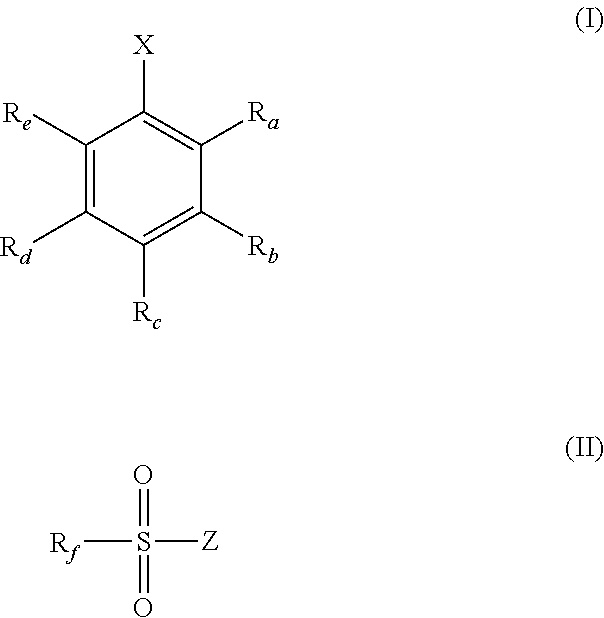
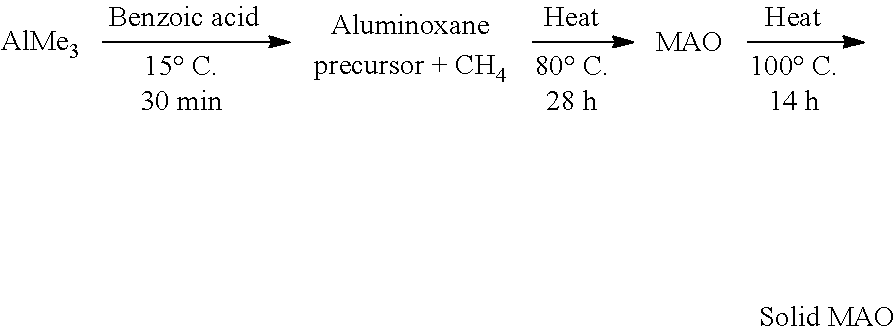
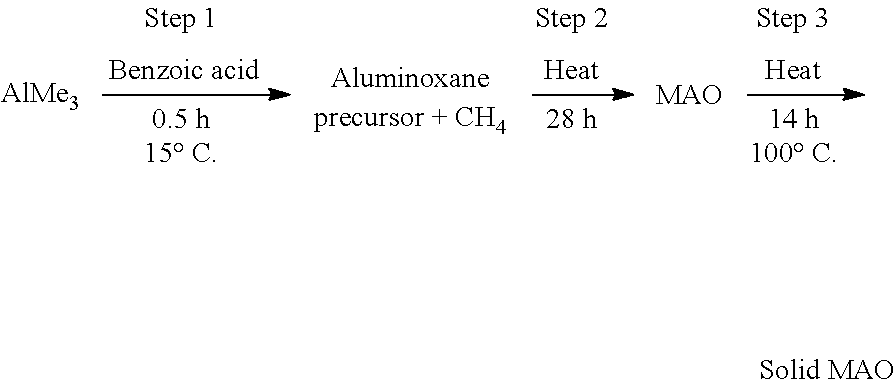


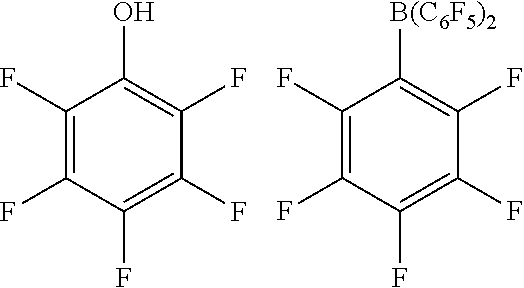
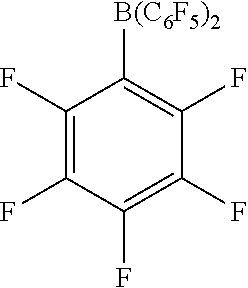
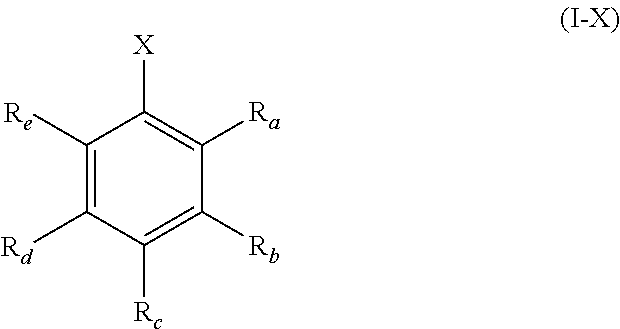




View All Diagrams
| United States Patent Application | 20190345273 |
| Kind Code | A1 |
| O'HARE; Dermot ; et al. | November 14, 2019 |
CATALYTIC SUPPORT AND USES THEREOF
Abstract
Solid-phase supported materials are described for use in supporting metallocene catalytic compounds. The supported metallocene catalytic compositions are efficient olefin polymerisation catalysts, which show notably higher catalytic activity compared to catalytic compounds employing conventional support materials.
| Inventors: | O'HARE; Dermot; (Oxford, GB) ; BUFFET; Jean-Charles; (Oxford, GB) ; KILPATRICK; Alexander; (Oxford, GB) ; SOMSOOK; Ekisath; (Bangkok, TH) ; NEALMONGKOLRATTANA; Nitiphat; (Bangkok, TH) ; CHAROENCHAIDET; Sumate; (Bangkok, TH) ; SRIPOTHONGNAK; Saovalak; (Bangkok, TH) | ||||||||||
| Applicant: |
|
||||||||||
|---|---|---|---|---|---|---|---|---|---|---|---|
| Family ID: | 56297305 | ||||||||||
| Appl. No.: | 16/098984 | ||||||||||
| Filed: | May 5, 2017 | ||||||||||
| PCT Filed: | May 5, 2017 | ||||||||||
| PCT NO: | PCT/GB2017/051257 | ||||||||||
| 371 Date: | November 5, 2018 |
| Current U.S. Class: | 1/1 |
| Current CPC Class: | C07F 5/068 20130101; C08F 10/02 20130101 |
| International Class: | C08F 10/02 20060101 C08F010/02; C07F 5/06 20060101 C07F005/06 |
Foreign Application Data
| Date | Code | Application Number |
|---|---|---|
| May 6, 2016 | GB | 1607989.9 |
Claims
1. A solid-phase support material suitable for supporting a metallocene catalytic compound, the solid-phase support material comprising a solid polymethylaluminoxane modified by reaction with a compound of formula (I) or (II) shown below: ##STR00026## wherein X is hydroxyl or a group B(Y).sub.2 or a group Al(Y).sub.2, wherein each Y is independently selected from hydroxyl, phenyl and naphthalenyl, any of which may be optionally substituted with one or more groups selected from halo, hydroxyl, (1-4C)alkyl, (2-4C)alkenyl, (2-4C)alkynyl and trihaloalkyl; R.sub.a and R.sub.b are independently hydrogen, hydroxyl, (1-4C)alkyl, (2-4C)alkenyl, (2-4C)alkynyl, halo or trihaloalkyl, or R.sub.a and R.sub.b are linked, such that, when taken with the atoms to which they are attached, they form a 6-membered aromatic ring that is optionally substituted by one or more groups selected from halo, 1-4C)alkyl, (2-4C)alkenyl, (2-4C)alkynyl and trihaloalkyl; R.sub.c, R.sub.d, and R.sub.e are each independently hydrogen, hydroxyl, (1-4C)alkyl, (2-4C)alkenyl, (2-4C)alkynyl, halo or trihaloalkyl; Z is hydroxyl or a group --NR.sub.xR.sub.y, wherein R.sub.x and R.sub.y are independently selected from hydrogen and (1-4C)alkyl; R.sub.f is (1-4C)alkyl, (2-4C)alkenyl, (2-4C)alkynyl, trihaloalkyl or a phenyl group that is optionally substituted with one or more groups selected from hydroxyl, (1-4C)alkyl, (2-4C)alkenyl, (2-4C)alkynyl, halo and trihaloalkyl; wherein the mole ratio of the compound of formula (I) or (II) to the solid polymethylaluminoxane within the solid-phase support material ranges from 0.0001:1 to 0.3:1.
2. (canceled)
3. The solid-phase support material of claim 1, wherein when X is hydroxyl i) R.sub.a, R.sub.b, R.sub.c, R.sub.d and R.sub.e are each independently halo; or ii) R.sub.a and R.sub.b are linked, such that, when taken with the atoms to which they are attached, they form a 6-membered aromatic ring that is optionally substituted by one or more groups selected from halo, 1-4C)alkyl, (2-4C)alkenyl, (2-4C)alkynyl and trihaloalkyl, and R.sub.c, R.sub.d, and R.sub.e are independently hydrogen, hydroxyl, (1-4C)alkyl, (2-4C)alkenyl, (2-4C)alkynyl, halo or trihaloalkyl; or iii) R.sub.a, R.sub.b and R.sub.e are each independently hydrogen, hydroxyl, (1-4C)alkyl, (2-4C)alkenyl, (2-4C)alkynyl, halo or trihaloalkyl, and R.sub.d and R.sub.e are each independently hydrogen, hydroxyl, (1-4C)alkyl, (2-4C)alkenyl, (2-4C)alkynyl or trihaloalkyl; or iv) R.sub.a, R.sub.b, R.sub.d and R.sub.e are each independently hydrogen, hydroxyl, (1-4C)alkyl, (2-4C)alkenyl, (2-4C)alkynyl, halo or trihaloalkyl, and R.sub.c is hydrogen, hydroxyl, (1-4C)alkyl, (2-4C)alkenyl, (2-4C)alkynyl or halo.
4. The solid-phase support material of claim 1, wherein each Y is independently selected from hydroxyl or a phenyl group that is optionally substituted with one or more groups selected from fluoro, hydroxyl, (1-4C)alkyl, (2-4C)alkenyl, (2-4C)alkynyl and trifluoroalkyl.
5. (canceled)
6. (canceled)
7. The solid-phase support material of claim 1, wherein R.sub.a, R.sub.b, R.sub.c, R.sub.d and R.sub.e are each independently hydrogen, hydroxyl, (1-4C)alkyl, 2-4C)alkenyl, (2-4C)alkynyl, fluoro or trifluoroalkyl.
8. (canceled)
9. (canceled)
10. The solid-phase support material of claim 1, wherein R.sub.f is (1-4C)alkyl, trihaloalkyl or a phenyl group that is optionally substituted with one or more groups selected from hydroxyl, (1-4C)alkyl, halo and trihaloalkyl.
11. (canceled)
12. (canceled)
13. The solid-phase support material of claim 1, wherein the mole ratio of the compound of formula (I) or (II) to the solid polymethylaluminoxane within the solid-phase support material ranges from 0.0001:1 to 0.1:1.
14. (canceled)
15. (canceled)
16. The solid-phase support material of claim 1, wherein the compound of formula (I) or (II) is selected from one or more of the following: ##STR00027##
17. (canceled)
18. (canceled)
19. The solid-phase support material of claim 1, wherein the solid-phase support material has an aluminium content of 23 to 40 wt %.
20. The solid-phase support material of pfeceding claim 1, wherein the BET surface area of the solid-phase support material is 10.0 to 20.0 m.sup.2 mmol.sub.Al.sup.-1.
21. A method of preparing a solid-phase support material of claim 1, the method comprising the steps of: a) providing a solid polymethylaluminoxane in a first solvent; b) contacting the solid polymethylaluminoxane of step a) with one or more compounds of formula (I) or (II) as defined in any preceding claim; and c) isolating the product formed from step b); wherein the mole ratio of the compound of formula (I) or (II) to the solid polymethylaluminoxane used in step b) ranges from 0.0001:1 to 0.3:1.
22. The method of claim 21, wherein the one or more compounds of formula (I) or (II) used in step b) is provided in a second solvent.
23. The method of claim 21, wherein step b) is conducted at a temperature of 18-150.degree. C.
24.-26. (canceled)
27. The method of claim 21, wherein step b) further comprises the step of sonicating the mixture of the solid polymethylaluminoxane and the one or more compounds of formula (I) or (II).
28.-30. (canceled)
31. The method of claim 21, wherein the first solvent is selected from toluene, benzene and hexane.
32. (canceled)
33. The method of claim 21, wherein the second solvent is selected from toluene, benzene and hexane.
34. (canceled)
35. The method of claim 21, wherein the mole ratio of the compound of formula (I) or (II) to the solid polymethylaluminoxane used in step b) ranges from 0.0001:1 to 0.1:1.
36. (canceled)
37. (canceled)
38. The method of claim 21, wherein step a) comprises the steps: i. precipitating a solid polymethylaluminoxane from a reaction medium, ii. isolating the precipitated solid polymethylaluminoxane from the reaction medium, and iii. dispersing the isolated solid polymethylaluminoxane in the first solvent.
39. (canceled)
40. A catalytic composition comprising: a) a compound of formula (III) ##STR00028## wherein R.sub.1 and R.sub.2 are each independently hydrogen or (1-2C)alkyl; R.sub.3 and R.sub.4 are each independently hydrogen or (1-4C)alkyl, or R.sub.3 and R.sub.4 are linked such that, when taken in combination with the atoms to which they are attached, they form a 6-membered fused aromatic ring optionally substituted with one or more groups selected from (1-6C)alkyl, (2-6C)alkenyl, (2-6C)alkynyl, (1-6C)alkoxy, aryl, heteroaryl, carbocyclic and heterocyclic, wherein each aryl, heteroaryl, carbocyclic and heterocyclic group is optionally substituted with one or more groups selected from (1-6C)alkyl, (2-6C)alkenyl, (2-6C)alkynyl, (1-6C)alkoxy, halo, amino, nitro, cyano, (1-6C)alkylamino, [(1-6C)alkyl].sub.2amino and --S(O).sub.2(1-6C)alkyl; R.sub.5 and R.sub.6 are each independently hydrogen or (1-4C)alkyl, or R.sub.3 and R.sub.4 are linked such that, when taken in combination with the atoms to which they are attached, they form a 6-membered fused aromatic ring optionally substituted with one or more groups selected from (1-6C)alkyl, (2-6C)alkenyl, (2-6C)alkynyl, (1-6C)alkoxy, aryl, heteroaryl, carbocyclic and heterocyclic, wherein each aryl, heteroaryl, carbocyclic and heterocyclic group is optionally substituted with one or more groups selected from (1-6C)alkyl, (2-6C)alkenyl, (2-6C)alkynyl, (1-6C)alkoxy, halo, amino, nitro, cyano, (1-6C)alkylamino, [(1-6C)alkyl].sub.2amino and --S(O).sub.2(1-6C)alkyl; R.sub.7 and R.sub.8 are each independently hydrogen or (1-4C)alkyl, or R.sub.3 and R.sub.4 are linked such that, when taken in combination with the atoms to which they are attached, they form a 6-membered fused aromatic ring optionally substituted with one or more groups selected from (1-6C)alkyl, (2-6C)alkenyl, (2-6C)alkynyl, (1-6C)alkoxy, aryl, heteroaryl, carbocyclic and heterocyclic, wherein each aryl, heteroaryl, carbocyclic and heterocyclic group is optionally substituted with one or more groups selected from (1-6C)alkyl, (2-6C)alkenyl, (2-6C)alkynyl, (1-6C)alkoxy, halo, amino, nitro, cyano, (1-6C)alkylamino, [(1-6C)alkyl].sub.2amino and --S(O).sub.2(1-6C)alkyl; Q is absent, or is a bridging group selected from --CH.sub.2-- or --CH.sub.2CH.sub.2--, either or which may be optionally substituted with one or more groups selected from (1-4C)alkyl, (2-4C)alkenyl, (2-4C)alkynyl and aryl, or Q is a bridging group --Si(R.sub.9)(R.sub.10)--, wherein R.sub.9 and R.sub.10 are independently (1-4C)alkyl, (2-4C)alkenyl, (2-4C)alkynyl or aryl; X is zirconium or hafnium; and each Y group is independently selected from halo, hydride, (1-6C)alkyl, (1-6C)alkoxy, aryl or aryloxy, either or which is optionally substituted with one or more groups selected from (1-6C)alkyl and halo; and b) a solid-phase support material of claim 1.
41.-51. (canceled)
52. A process for the preparation of a polyolefin, comprising polymerizing at least one monomer in the presence of a catalytic composition of claim 40.
53. (canceled)
54. The process of claim 52, wherein the polyolefin is a copolymer formed from ethene monomers comprising 1-10 wt %, by total weight of the monomer, of one or more (4-8C) .alpha.-olefin.
Description
INTRODUCTION
[0001] The present invention relates to catalytic support materials and uses thereof. More particularly, the present invention relates to catalytic support materials based on solid polymethylaluminoxane, as well as the use of such materials in polymerisation of olefins.
BACKGROUND OF THE INVENTION
[0002] It is well known that ethylene (and .alpha.-olefins in general) can be readily polymerised at low or medium pressures in the presence of certain transition metal catalysts. These catalysts are generally known as Zeigler-Natta type catalysts.
[0003] A particular group of these Ziegler-Natta type catalysts, which catalyse the polymerization of ethylene (and .alpha.-olefins in general), comprise an aluminoxane activator and a metallocene transition metal catalyst. Metallocenes comprise a metal bound between two .eta.5-cyclopentadienyl type ligands. Generally the .eta..sup.5-cyclopentadienyl type ligands are selected from .eta..sup.5-cyclopentadienyl, .eta..sup.5-indenyl and .eta..sup.5-fluorenyl.
[0004] Catalytic reactions involving metallocene-based Ziegler-Natta catalysts have traditionally employed the catalyst in solution phase. However, this technique has a number of drawbacks, most notably the difficulty of effectively separating the catalyst from the reaction medium and then recycling it for further use.
[0005] Given the high value that industry places on polyethylene (as well as other polyolefins), there is a need for improved solid-phase support materials capable of effectively supporting metallocene-based Ziegler-Natta catalysts.
[0006] The present invention was devised with the foregoing in mind.
SUMMARY OF THE INVENTION
[0007] According to a first aspect of the present invention there is provided a solid-phase support material suitable for supporting a metallocene catalytic compound, the solid-phase support material comprising a solid polymethylaluminoxane modified by reaction with a compound of formula (I) or (II) defined herein, wherein the mole ratio of the compound of formula (I) or (II) to the solid polymethylaluminoxane within the solid-phase support material ranges from 0.0001:1 to 0.3:1.
[0008] According to a further aspect of the present invention, there is provided a method of preparing a solid-phase support material as claimed in any preceding claim, the method comprising the steps of: [0009] a) providing a solid polymethylaluminoxane in a first solvent; [0010] b) contacting the solid polymethylaluminoxane of step a) with one or more compounds of formula (I) or (II) as defined herein; and [0011] c) isolating the product formed from step b); wherein the mole ratio of the compound of formula (I) or (II) to the solid polymethylaluminoxane used in step b) ranges from 0.0001:1 to 0.3:1.
[0012] According to a further aspect of the present invention, there is provided a solid-phase support material obtained, directly obtained or obtainable by a process defined herein.
[0013] According to a further aspect of the present invention, there is provided a use of a solid-phase support material defined herein as a solid-phase support for supporting a metallocene catalytic compound.
[0014] According to a further aspect of the present invention, there is provided a catalytic composition comprising: [0015] a) a compound of formula (III) defined herein; and [0016] b) a solid-phase support material as defined herein.
[0017] According to a further aspect of the present invention, there is provided a method for the preparation of a catalytic composition defined herein, the method comprising the steps of: [0018] a) providing a solid-phase support material as defined herein in a suitable solvent [0019] b) contacting the solid-phase support material of step a) with a compound of formula (III) defined herein; and [0020] c) isolating the product resulting from step b).
[0021] According to a further aspect of the present invention, there is provided a catalytic composition obtained, directly obtained or obtainable by a process defined herein.
[0022] According to a further aspect of the present invention, there is provided a use of a catalytic composition as defined herein as a polymerisation catalyst for the preparation of a polyolefin.
[0023] According to a further aspect of the present invention, there is provided a process for forming a polyolefin (e.g. a polyethylene), the process comprising the step of reacting olefin monomers in the presence of a catalytic composition defined herein.
DETAILED DESCRIPTION OF THE INVENTION
Definitions
[0024] The term "alkyl" as used herein includes reference to a straight or branched chain alkyl moieties, typically having 1, 2, 3, 4, 5 or 6 carbon atoms. This term includes reference to groups such as methyl, ethyl, propyl (n-propyl or isopropyl), butyl (n-butyl, sec-butyl or tert-butyl), pentyl (including neopentyl), hexyl and the like. In particular, an alkyl may have 1, 2, 3 or 4 carbon atoms.
[0025] The term "alkenyl" as used herein include reference to straight or branched chain alkenyl moieties, typically having 2, 3, 4, 5 or 6 carbon atoms. The term includes reference to alkenyl moieties containing 1, 2 or 3 carbon-carbon double bonds (C.dbd.C). This term includes reference to groups such as ethenyl (vinyl), propenyl (allyl), butenyl, pentenyl and hexenyl, as well as both the cis and trans isomers thereof.
[0026] The term "alkynyl" as used herein include reference to straight or branched chain alkynyl moieties, typically having 2, 3, 4, 5 or 6 carbon atoms. The term includes reference to alkynyl moieties containing 1, 2 or 3 carbon-carbon triple bonds (C.ident.C). This term includes reference to groups such as ethynyl, propynyl, butynyl, pentynyl and hexynyl.
[0027] The term "alkoxy" as used herein include reference to --O-alkyl, wherein alkyl is straight or branched chain and comprises 1, 2, 3, 4, 5 or 6 carbon atoms. In one class of embodiments, alkoxy has 1, 2, 3 or 4 carbon atoms. This term includes reference to groups such as methoxy, ethoxy, propoxy, isopropoxy, butoxy, tert-butoxy, pentoxy, hexoxy and the like.
[0028] The term "aryl" as used herein includes reference to an aromatic ring system comprising 6, 7, 8, 9 or 10 ring carbon atoms. Aryl is often phenyl but may be a polycyclic ring system, having two or more rings, at least one of which is aromatic. This term includes reference to groups such as phenyl, naphthyl and the like.
[0029] The term "carbocyclyl" as used herein includes reference to an alicyclic moiety having 3, 4, 5, 6, 7 or 8 carbon atoms. The group may be a bridged or polycyclic ring system. More often cycloalkyl groups are monocyclic. This term includes reference to groups such as cyclopropyl, cyclobutyl, cyclopentyl, cyclohexyl, norbornyl, bicyclo[2.2.2]octyl and the like.
[0030] The term "heterocyclyl" as used herein includes reference to a saturated (e.g. heterocycloalkyl) or unsaturated (e.g. heteroaryl) heterocyclic ring moiety having from 3, 4, 5, 6, 7, 8, 9 or 10 ring atoms, at least one of which is selected from nitrogen, oxygen, phosphorus, silicon and sulphur. In particular, heterocyclyl includes a 3- to 10-membered ring or ring system and more particularly a 5- or 6-membered ring, which may be saturated or unsaturated.
[0031] A heterocyclic moiety is, for example, selected from oxiranyl, azirinyl, 1,2-oxathiolanyl, imidazolyl, thienyl, furyl, tetrahydrofuryl, pyranyl, thiopyranyl, thianthrenyl, isobenzofuranyl, benzofuranyl, chromenyl, 2H-pyrrolyl, pyrrolyl, pyrrolinyl, pyrrolidinyl, imidazolyl, imidazolidinyl, benzimidazolyl, pyrazolyl, pyrazinyl, pyrazolidinyl, thiazolyl, isothiazolyl, dithiazolyl, oxazolyl, isoxazolyl, pyridyl, pyrazinyl, pyrimidinyl, piperidyl, piperazinyl, pyridazinyl, morpholinyl, thiomorpholinyl, especially thiomorpholino, indolizinyl, isoindolyl, 3H-indolyl, indolyl, benzimidazolyl, cumaryl, indazolyl, triazolyl, tetrazolyl, purinyl, 4H-quinolizinyl, isoquinolyl, quinolyl, tetrahydroquinolyl, tetrahydroisoquinolyl, decahydroquinolyl, octahydroisoquinolyl, benzofuranyl, dibenzofuranyl, benzothiophenyl, dibenzothiophenyl, phthalazinyl, naphthyridinyl, quinoxalyl, quinazolinyl, quinazolinyl, cinnolinyl, pteridinyl, carbazolyl, .beta.-carbolinyl, phenanthridinyl, acridinyl, perimidinyl, phenanthrolinyl, furazanyl, phenazinyl, phenothiazinyl, phenoxazinyl, chromenyl, isochromanyl, chromanyl and the like.
[0032] The term "heteroaryl" as used herein includes reference to an aromatic heterocyclic ring system having 5, 6, 7, 8, 9 or 10 ring atoms, at least one of which is selected from nitrogen, oxygen and sulphur. The group may be a polycyclic ring system, having two or more rings, at least one of which is aromatic, but is more often monocyclic. This term includes reference to groups such as pyrimidinyl, furanyl, benzo[b]thiophenyl, thiophenyl, pyrrolyl, imidazolyl, pyrrolidinyl, pyridinyl, benzo[b]furanyl, pyrazinyl, purinyl, indolyl, benzimidazolyl, quinolinyl, phenothiazinyl, triazinyl, phthalazinyl, 2H-chromenyl, oxazolyl, isoxazolyl, thiazolyl, isoindolyl, indazolyl, purinyl, isoquinolinyl, quinazolinyl, pteridinyl and the like.
[0033] The term "halogen" or "halo" as used herein includes reference to F, Cl, Br or I. In a particular, halogen may be F or Cl, of which Cl is more common.
[0034] The term "substituted" as used herein in reference to a moiety means that one or more, especially up to 5, more especially 1, 2 or 3, of the hydrogen atoms in said moiety are replaced independently of each other by the corresponding number of the described substituents. The term "optionally substituted" as used herein means substituted or unsubstituted.
[0035] It will, of course, be understood that substituents are only at positions where they are chemically possible, the person skilled in the art being able to decide (either experimentally or theoretically) without inappropriate effort whether a particular substitution is possible. For example, amino or hydroxy groups with free hydrogen may be unstable if bound to carbon atoms with unsaturated (e.g. olefinic) bonds. Additionally, it will of course be understood that the substituents described herein may themselves be substituted by any substituent, subject to the aforementioned restriction to appropriate substitutions as recognised by the skilled person.
Solid Phase Support Material
[0036] As discussed hereinbefore, the present invention provides a solid-phase support material suitable for supporting a metallocene catalytic compound, the solid-phase support material comprising a solid polymethylaluminoxane modified by reaction with a compound of formula (I) or (II) shown below:
##STR00001## [0037] wherein [0038] X is hydroxyl or a group B(Y).sub.2 or a group Al(Y).sub.2, [0039] wherein each Y is independently selected from hydroxyl, phenyl and naphthalenyl, any of which may be optionally substituted with one or more groups selected from halo, hydroxyl, (1-4C)alkyl, (2-4C)alkenyl, (2-4C)alkynyl and trihaloalkyl; [0040] R.sub.a and R.sub.b are independently hydrogen, hydroxyl, (1-4C)alkyl, (2-4C)alkenyl, (2-4C)alkynyl, halo or trihaloalkyl, or [0041] R.sub.a and R.sub.b are linked, such that, when taken with the atoms to which they are attached, they form a 6-membered aromatic ring that is optionally substituted by one or more groups selected from halo, (1-4C)alkyl, (2-4C)alkenyl, (2-4C)alkynyl and trihaloalkyl; [0042] R.sub.c-R.sub.e are independently hydrogen, hydroxyl, (1-4C)alkyl, (2-4C)alkenyl, (2-4C)alkynyl, halo or trihaloalkyl; [0043] Z is hydroxyl or a group --NR.sub.xR.sub.y, [0044] wherein R.sub.x and R.sub.y are independently selected from hydrogen and (1-4C)alkyl; [0045] R.sub.f is (1-4C)alkyl, (2-4C)alkenyl, (2-4C)alkynyl, trihaloalkyl or a phenyl group that is optionally substituted with one or more groups selected from hydroxyl, (1-4C)alkyl, (2-4C)alkenyl, (2-4C)alkynyl, halo and trihaloalkyl; [0046] wherein the mole ratio of the compound of formula (I) or (II) to the solid polyaluminoxane within the solid-phase support material ranges from 0.0001:1 to 0.3:1.
[0047] The solid-phase support materials of the invention present a number of advantages over other solid-phase support material. Perhaps most notably, when used in the preparation of supported metallocene-based Ziegla-Natta catalysts for use in the polymerisation of olefins, the solid-phase support materials of the invention give rise to a marked increase in catalytic activity.
[0048] It will be understood that the term "solid polymethylaluminoxane" and "solid MAO" as used herein synonymously refer to a solid-phase material having the general formula --[(Me)AlO].sub.n--, wherein n is an integer from 10 to 50. Any suitable solid polymethylaluminoxane may be used.
[0049] There exist numerous substantial structural and behavioural differences between solid polymethylaluminoxane and other (non-solid) methyl aluminoxanes. Perhaps most notably, solid polymethylaluminoxane is distinguished from other methyl aluminoxanes (MAOs) as it is insoluble in hydrocarbon solvents and so acts as a heterogeneous support system. The solid polymethylaluminoxanes useful in the preparation of the solid-phase support material of the invention are insoluble in toluene and hexane.
[0050] In contrast to non-solid (hydrocarbon-soluble) methyl aluminoxanes, which are traditionally used as an activator species in slurry polymerisation or to modify the surface of a separate solid support material (e.g. SiO.sub.2), the solid polyaluminoxanes useful as part of the present invention are themselves suitable for use as solid-phase support materials, without the need for an additional activator. Hence, the solid-phase support materials of the invention are devoid of any other species that could be considered a solid support (e.g. inorganic material such as SiO.sub.2, Al.sub.2O.sub.3 and ZrO.sub.2). Similarly, the only inorganic solid support employed in the catalytic compositions of the invention is the solid-phase support material of the invention (i.e. no additional solid support such as SiO.sub.2, Al.sub.2O.sub.3 and ZrO.sub.2 are necessary). Moreover, given the dual function of the solid-phase support materials of the invention (as catalytic support and activator species), the catalytic compositions of the invention contain no additional catalytic activator species.
[0051] In an embodiment, the solid polymethylaluminoxane is prepared by heating a solution containing polymethylaluminoxane and a hydrocarbon solvent (e.g. toluene), so as to precipitate solid polymethylaluminoxane. The solution containing polymethylaluminoxane and a hydrocarbon solvent may be prepared by reacting trimethyl aluminium and benzoic acid in a hydrocarbon solvent (e.g. toluene), and then heating the resulting mixture.
[0052] In an embodiment, the solid polymethylaluminoxane is prepared according to the following protocol:
##STR00002##
The properties of the solid polymethylaluminoxane can be adjusted by altering one or more of the processing variables used during its synthesis. For example, in the above-outlined protocol, the properties of the solid polymethylaluminoxane may be adjusted by varying the Al:O ratio, by fixing the amount of AlMe.sub.3 and varying the amount of benzoic acid. Exemplary Al:O ratios are 1:1, 1.1:1, 1.2:1, 1.3:1, 1.4:1 and 1.6:1. Suitably the Al:O ratio is 1.2:1 or 1.3:1. Alternatively, the properties of the solid polymethylaluminoxane may be adjusted by fixing the amount of benzoic acid and varying the amount of AlMe.sub.3.
[0053] In another embodiment, the solid polymethylaluminoxane is prepared according to the following protocol:
##STR00003##
[0054] In the above protocol, steps 1 and 2 may be kept constant, with step 2 being varied. The temperature of step 2 may be 70-100.degree. C. (e.g. 70.degree. C., 80.degree. C., 90.degree. C. or 100.degree. C.). The duration of step 2 may be from 12 to 28 hours (e.g. 12, 20 or 28 hours). The duration of step 2 may be from 5 minutes to 24 hours. Step 3 may be conducted in a solvent such as toluene.
[0055] In an embodiment, the aluminium content of the solid polymethylaluminoxane falls within the range of 36-41 wt %.
[0056] The solid polymethylaluminoxane useful as part of the present invention is characterised by extremely low solubility in toluene and n-hexane. In an embodiment, the solubility in n-hexane at 25.degree. C. of the solid polymethylaluminoxane is 0-2 mol %. Suitably, the solubility in n-hexane at 25.degree. C. of the solid polymethylaluminoxane is 0-1 mol %. More suitably, the solubility in n-hexane at 25.degree. C. of the solid polymethylaluminoxane is 0-0.2 mol %. Alternatively or additionally, the solubility in toluene at 25.degree. C. of the solid polymethylaluminoxane is 0-2 mol %. Suitably, the solubility in toluene at 25.degree. C. of the solid polymethylaluminoxane is 0-1 mol %. More suitably, the solubility in toluene at 25.degree. C. of the solid polymethylaluminoxane is 0-0.5 mol %. The solubility in solvents can be measured by the method described in JP--B(KOKOKU)-H07 42301.
[0057] In a particularly suitable embodiment, the solid polymethylaluminoxane is as described in US2013/0059990, WO2010/055652 or WO2013/146337, and is obtainable from Tosoh Finechem Corporation, Japan.
[0058] In an embodiment, the mole ratio of the compound of formula (I) or (II) to the solid polymethylaluminoxane within the solid-phase support material ranges from 0.0001:1 to 0.2:1.
[0059] Suitably, the mole ratio of the compound of formula (I) or (II) to the solid polymethylaluminoxane within the solid-phase support material ranges from 0.0001:1 to 0.1:1.
[0060] More suitably, the mole ratio of the compound of formula (I) or (II) to the solid polymethylaluminoxane within the solid-phase support material ranges from 0.0001:1 to 0.07:1.
[0061] Most suitably, the mole ratio of the compound of formula (I) or (II) to the solid polymethylaluminoxane within the solid-phase support material ranges from 0.0001:1 to 0.05:1.
[0062] In an embodiment, Z is hydroxyl.
[0063] In another embodiment, X is hydroxyl or a group B(Y).sub.2.
[0064] In another embodiment, X is hydroxyl or a group Al(Y).sub.2.
[0065] In another embodiment, each Y is independently selected from hydroxyl, phenyl and naphthalenyl, any of which may be optionally substituted with one or more groups selected from fluoro, hydroxyl, (1-4C)alkyl, (2-4C)alkenyl, (2-4C)alkynyl and trifluoroalkyl.
[0066] In another embodiment, each Y is independently selected from hydroxyl or a phenyl group that is optionally substituted with one or more groups selected from fluoro, hydroxyl, (1-4C)alkyl, (2-4C)alkenyl, (2-4C)alkynyl and trifluoroalkyl.
[0067] Suitably, each Y is independently selected from hydroxyl or a phenyl group that is optionally substituted with one or more groups selected from fluoro, (1-4C)alkyl and trifluoromethyl.
[0068] More suitably, each Y is independently selected from hydroxyl or a phenyl group that is optionally substituted with one or more groups selected from fluoro and trifluoromethyl.
[0069] In an embodiment, R.sub.a-R.sub.e are each independently hydrogen, hydroxyl, (1-4C)alkyl, (2-4C)alkenyl, (2-4C)alkynyl, halo or trihaloalkyl, or R.sub.a and R.sub.b are linked, such that, when taken with the atoms to which they are attached, they form a 6-membered aromatic ring that is optionally substituted by one or more groups selected from halo and trihaloalkyl.
[0070] Suitably, R.sub.a-R.sub.e are each independently hydrogen, hydroxyl, (1-4C)alkyl, (2-4C)alkenyl, (2-4C)alkynyl, halo or trihaloalkyl, or R.sub.a and R.sub.b are linked, such that, when taken with the atoms to which they are attached, they form a 6-membered aromatic ring that is optionally substituted by four groups, each being independently selected from halo (e.g. fluoro) and trihaloalkyl (e.g. trifluoromethyl).
[0071] More suitably, R.sub.a-R.sub.e are independently hydrogen, hydroxyl, (1-4C)alkyl, 2-4C)alkenyl, (2-4C)alkynyl, fluoro or trifluoroalkyl.
[0072] Even more suitably, R.sub.a-R.sub.e are independently hydrogen, (1-4C)alkyl, fluoro or trifluoroalkyl.
[0073] Most suitably, R.sub.a-R.sub.e are independently hydrogen, methyl, ethyl, tert-butyl, fluoro or trifluoromethyl.
[0074] In another embodiment, R.sub.f is (1-4C)alkyl, trihaloalkyl or a phenyl group that is optionally substituted with one or more groups selected from hydroxyl, (1-4C)alkyl, halo and trihaloalkyl.
[0075] Suitably, R.sub.f is (1-4C)alkyl, trihaloalkyl or p-toluenyl.
[0076] More suitably, wherein R.sub.f is methyl, ethyl, trifluoromethyl or p-toluenyl.
[0077] In an embodiment, the compound of formula (I) or formula (II) is selected from one or more of the following:
##STR00004##
[0078] In an embodiment, the compound of formula (I) or formula (II) is selected from one or more of the following:
##STR00005##
[0079] Suitably, the compound of formula (I) or (II) is selected from one or more of the following:
##STR00006##
[0080] Most suitably, the compound of formula (I) or (II) is:
##STR00007##
[0081] In an embodiment, the solid-phase support material has an aluminium content of 23 to 40 wt %. Suitably, the solid-phase support material has an aluminium content of 28 to 40 wt %.
[0082] The aluminium content of the solid-phase support material can be determined, for example, by ICP-MS.
[0083] In an embodiment, the BET surface area of the solid-phase support material is 10.0 to 20.0 m.sup.2mmol.sub.Al.sup.-1.
[0084] In another aspect, the present invention also provides a solid-phase support material suitable for supporting a metallocene catalytic compound, the solid-phase support material comprising a solid polymethylaluminoxane modified by reaction with a compound of formula (I-X) shown below:
##STR00008##
wherein
[0085] X is hydroxyl or a group B(Y).sub.2, [0086] wherein each Y is pentafluorophenyl; and
[0087] R.sub.a-R.sub.e are each fluoro.
[0088] In an embodiment, the mole ratio of the compound of formula (I-X) to the solid polymethylaluminoxane within the solid-phase support material ranges from 0.0001:1 to 1:1.
Preparation of Solid-Phase Support Material
[0089] As described hereinbefore, the present invention also provides a method of preparing a solid-phase support material described herein, the method comprising the steps of: [0090] a) providing a solid polymethylaluminoxane in a first solvent; [0091] b) contacting the solid polymethylaluminoxane of step a) with one or more compounds of formula (I) or (II) as defined herein; and [0092] c) isolating the product formed from step b); wherein the mole ratio of the compound of formula (I) or (II) to the solid polymethylaluminoxane used in step b) ranges from 0.0001:1 to 0.3:1.
[0093] The solid-phase support materials of the invention are straightforwardly prepared using mild reaction conditions.
[0094] Step a) may comprise the steps of: [0095] i. precipitating a solid polymethylaluminoxane from a reaction medium, [0096] ii. isolating the precipitated solid polymethylaluminoxane from the reaction medium, and [0097] iii. dispersing the isolated solid polymethylaluminoxane in the first solvent.
[0098] In an embodiment, the one or more compounds of formula (I) or (II) used in step b) is provided in a second solvent.
[0099] The first and second solvents may the same or different. Any suitable aromatic or aliphatic may be used, including toluene, benzene and hexane. In an embodiment, both the first and second solvent are toluene.
[0100] Step b) may be conducted at a temperature of 18-150.degree. C. Suitably, step b) is conducted at a temperature of 18-50.degree. C. More suitably, step b) is conducted at a temperature of 20-30.degree. C.
[0101] Suitably, step b) involves mixing the solid polymethylaluminoxane of step a) with the one or more compounds of formula (I) or (II) as defined herein.
[0102] In an embodiment, step b) further comprises the step of sonicating the mixture of the solid polymethylaluminoxane and the one or more compounds of formula (I) or (II). Sonication may be performed for a period of 0.1-24 hours or a period of 0.1-5 hours. Suitably, sonication is performed for a period of 0.5-1.5 hours. When sonication is used, step b) is suitably conducted at a temperature of 10-65.degree. C., preferably 18-50.degree. C. More suitably, when sonication is used, step b) is suitably conducted at a temperature of 18-35.degree. C.
[0103] In an embodiment, step b) further comprises the step of sonicating the mixture of the solid polymethylaluminoxane and the one or more compounds of formula (I) or (II), wherein the temperature of the mixture when sonication begins is 15-25.degree. C., and wherein the temperature of the mixture rises to 40-80.degree. C. (e.g. 40-65.degree. C.) during the course of sonication.
[0104] In an embodiment, when step b) comprises sonicating the mixture of the solid polymethylaluminoxane and the one or more compounds of formula (I) or (II), the temperature of the mixture may not rise above 85.degree. C. over the course of step b). Suitably, when step b) comprises sonicating the mixture of the solid polymethylaluminoxane and the one or more compounds of formula (I) or (II), the temperature of the mixture may not rise above 65.degree. C. over the course of step b).
[0105] Any suitable sonicating technique may be used. Suitably, when sonication is used in step b), it is conducted in a sonicating water bath. Suitably, the ultrasonic frequency used in step b) is >15 kHz.
[0106] The inventors have surprisingly found that sonicating the mixture of the solid polymethylaluminoxane and the one or more compounds of formula (I) or (II) advantageously obviates the need for conducting step b) at high temperatures, which is believed to result in degradation of the solid-phase support material.
[0107] In an embodiment, the mole ratio of the compound of formula (I) or (II) to the solid polymethylaluminoxane used in step b) ranges from 0.0001:1 to 0.2:1. Suitably, the mole ratio of the compound of formula (I) or (II) to the solid polymethylaluminoxane used in step b) ranges from 0.0001:1 to 0.1:1. More suitably, the mole ratio of the compound of formula (I) or (II) to the solid polymethylaluminoxane used in step b) ranges from 0.0001:1 to 0.07:1. Most suitably, the mole ratio of the compound of formula (I) or (II) to the solid polymethylaluminoxane used in step b) ranges from 0.0001:1 to 0.05:1.
[0108] In another aspect, the present invention also provides a method of preparing a solid-phase support material described herein, the method comprising the steps of: [0109] a) providing a solid polymethylaluminoxane in a first solvent; [0110] b) contacting the solid polymethylaluminoxane of step a) with one or more compounds of formula (I-X); and [0111] c) isolating the product formed from step b).
Catalytic Compositions
[0112] As described hereinbefore, the present invention also provides a catalytic composition comprising: [0113] a) a compound of formula (III) shown below; and [0114] b) a solid-phase support material as defined herein
[0114] ##STR00009## [0115] wherein [0116] R.sub.1 and R.sub.2 are each independently hydrogen or (1-2C)alkyl; [0117] R.sub.3 and R.sub.4 are each independently hydrogen or (1-4C)alkyl, or R.sub.3 and R.sub.4 are linked such that, when taken in combination with the atoms to which they are attached, they form a 6-membered fused aromatic ring optionally substituted with one or more groups selected from (1-6C)alkyl, (2-6C)alkenyl, (2-6C)alkynyl, (1-6C)alkoxy, aryl, heteroaryl, carbocyclic and heterocyclic, wherein each aryl, heteroaryl, carbocyclic and heterocyclic group is optionally substituted with one or more groups selected from (1-6C)alkyl, (2-6C)alkenyl, (2-6C)alkynyl, (1-6C)alkoxy, halo, amino, nitro, cyano, (1-6C)alkylamino, [(1-6C)alkyl].sub.2amino and --S(O).sub.2(1-6C)alkyl; [0118] R.sub.5 and R.sub.6 are each independently hydrogen or (1-4C)alkyl, or R.sub.3 and R.sub.4 are linked such that, when taken in combination with the atoms to which they are attached, they form a 6-membered fused aromatic ring optionally substituted with one or more groups selected from (1-6C)alkyl, (2-6C)alkenyl, (2-6C)alkynyl, (1-6C)alkoxy, aryl, heteroaryl, carbocyclic and heterocyclic, wherein each aryl, heteroaryl, carbocyclic and heterocyclic group is optionally substituted with one or more groups selected from (1-6C)alkyl, (2-6C)alkenyl, (2-6C)alkynyl, (1-6C)alkoxy, halo, amino, nitro, cyano, (1-6C)alkylamino, [(1-6C)alkyl].sub.2amino and --S(O).sub.2(1-6C)alkyl; [0119] R.sub.7 and R.sub.8 are each independently hydrogen or (1-4C)alkyl, or R.sub.3 and R.sub.4 are linked such that, when taken in combination with the atoms to which they are attached, they form a 6-membered fused aromatic ring optionally substituted with one or more groups selected from (1-6C)alkyl, (2-6C)alkenyl, (2-6C)alkynyl, (1-6C)alkoxy, aryl, heteroaryl, carbocyclic and heterocyclic, wherein each aryl, heteroaryl, carbocyclic and heterocyclic group is optionally substituted with one or more groups selected from (1-6C)alkyl, (2-6C)alkenyl, (2-6C)alkynyl, (1-6C)alkoxy, halo, amino, nitro, cyano, (1-6C)alkylamino, [(1-6C)alkyl].sub.2amino and --S(O).sub.2(1-6C)alkyl; [0120] Q is absent (in which case each cycopentadienyl ring is bound to hydrogen at this position), or is a bridging group selected from --CH.sub.2-- or --CH.sub.2CH.sub.2--, either or which may be optionally substituted with one or more groups selected from (1-4C)alkyl, (2-4C)alkenyl, (2-4C)alkynyl and aryl, or Q is a bridging group --Si(R.sub.9)(R.sub.10)--, [0121] wherein R.sub.9 and R.sub.10 are independently (1-4C)alkyl, (2-4C)alkenyl, (2-4C)alkynyl or aryl; [0122] X is zirconium or hafnium; and [0123] each Y group is independently selected from halo, hydride, (1-6C)alkyl, (1-6C)alkoxy, aryl or aryloxy, either or which is optionally substituted with one or more groups selected from (1-6C)alkyl and halo.
[0124] It will be appreciated that the structural formula (III) presented above is intended to show the substituent groups in a clear manner. A more representative illustration of the spatial arrangement of the groups is shown in the alternative representation below:
##STR00010##
[0125] It will also be appreciated that, depending on the identities of substituents R.sub.1-R.sub.8, the compounds of the present invention may be present as meso or rac isomers, and the present invention includes both such isomeric forms. A person skilled in the art will appreciate that a mixture of isomers of the compound of the present invention may be used for catalysis applications, or the isomers may be separated and used individually (using techniques well known in the art, such as, for example, fractional crystallization).
[0126] If the structure of a compound of formula (III) is such that rac and meso isomers do exist, the compound may be present in the rac form only, or in the meso form only.
[0127] The catalytic compositions of the invention exhibit superior catalytic performance when compared with current metallocene compounds/compositions used in the polymerisation of .alpha.-olefins. In particular, when compared with analogous solid MAO-supported the compositions of the invention, containing a modified solid MAO support material, exhibit significantly increased catalytic activity in the homopolymerisation and copolymerisation of .alpha.-olefins.
[0128] The compound of formula (III) may be immobilized on the solid phase support material by one or more ionic or covalent interactions.
[0129] In the compositions of the invention, the solid-phase support materials of the invention are the only inorganic solid supports used (i.e. no additional solid support such as SiO.sub.2, Al.sub.2O.sub.3 and ZrO.sub.2 are necessary). Moreover, given the dual function of the solid-phase support materials of the invention (as catalytic support and activator species), the catalytic compositions of the invention contain no additional catalytic activator species.
[0130] In an embodiment, R.sub.1 and R.sub.2 are each hydrogen.
[0131] In another embodiment, R.sub.3 and R.sub.4 are each independently hydrogen or (1-4C)alkyl, or R.sub.3 and R.sub.4 are linked such that, when taken in combination with the atoms to which they are attached, they form a 6-membered fused aromatic ring optionally substituted with one or more groups selected from (1-6C)alkyl, (2-6C)alkenyl, (2-6C)alkynyl and (1-6C)alkoxy.
[0132] Suitably, R.sub.3 and R.sub.4 are each independently hydrogen or (1-4C)alkyl, or R.sub.3 and R.sub.4 are linked such that, when taken in combination with the atoms to which they are attached, they form a 6-membered fused aromatic ring optionally substituted with one or more groups selected from methyl, ethyl and tert-butyl.
[0133] In another embodiment, R.sub.5 and R.sub.6 are each independently hydrogen or (1-4C)alkyl, or R.sub.5 and R.sub.6 are linked such that, when taken in combination with the atoms to which they are attached, they form a 6-membered fused aromatic ring optionally substituted with one or more groups selected from (1-6C)alkyl, (2-6C)alkenyl, (2-6C)alkynyl and (1-6C)alkoxy.
[0134] Suitably, R.sub.5 and R.sub.6 are each independently hydrogen or (1-4C)alkyl, or R.sub.5 and R.sub.6 are linked such that, when taken in combination with the atoms to which they are attached, they form a 6-membered fused aromatic ring optionally substituted with one or more groups selected from methyl, ethyl and tert-butyl.
[0135] In another embodiment, R.sub.7 and R.sub.8 are each independently hydrogen or (1-4C)alkyl, or R.sub.7 and R.sub.8 are linked such that, when taken in combination with the atoms to which they are attached, they form a 6-membered fused aromatic ring optionally substituted with one or more groups selected from (1-6C)alkyl, (2-6C)alkenyl, (2-6C)alkynyl and (1-6C)alkoxy.
[0136] Suitably, R.sub.7 and R.sub.8 are each independently hydrogen or (1-4C)alkyl, or R.sub.7 and R.sub.8 are linked such that, when taken in combination with the atoms to which they are attached, they form a 6-membered fused aromatic ring optionally substituted with one or more groups selected from methyl, ethyl and tert-butyl.
[0137] In another embodiment, Q is absent, or is a bridging group selected from --CH.sub.2-- or --CH.sub.2CH.sub.2--, either or which may be optionally substituted with one or more groups selected from (1-4C)alkyl and phenyl, or Q is a bridging group --Si(R.sub.9)(R.sub.10)--,
wherein R.sub.9 and R.sub.10 are independently (1-4C)alkyl or aryl.
[0138] In another embodiment, X is zirconium.
[0139] In another embodiment, each Y group is independently selected from halo.
[0140] Suitably, each Y group is chloro.
[0141] In another embodiment, the compound of formula (III) has a structure according to either of formulae (IIIa) or (IIIb) shown below:
##STR00011##
wherein
[0142] X, R.sub.1a, R.sub.2a, R.sub.3a, R.sub.4a, R.sub.5a, R.sub.6a, R.sub.7a and R.sub.8a have any of the definitions recited respectively hereinbefore for X, R.sub.1, R.sub.2, R.sub.3, R.sub.4, R.sub.5, R.sub.6, R.sub.7 and R.sub.8
##STR00012##
wherein
[0143] Q, X, R.sub.1b, R.sub.2b, R.sub.3b, R.sub.4b, R.sub.5b and R.sub.6b have any of the definitions recited respectively hereinbefore for Q, X, R.sub.1, R.sub.2, R.sub.3, R.sub.4, R.sub.5 and R.sub.6;
[0144] each R.sub.z is independently halo, (1-4C)alkyl or phenyl; and
[0145] n is 0, 1,2, 3 or 4.
[0146] In another embodiment, the compound of formula (III) has a structure according to formula (IIIa), wherein X is Zr.
[0147] In another embodiment, the compound of formula (III) has a structure according to formula (IIIa), wherein R.sub.1a, R.sub.2a, R.sub.5a and R.sub.6a are each hydrogen.
[0148] In another embodiment, the compound of formula (III) has a structure according to formula (IIIa), wherein
R.sub.1a, R.sub.2a, R.sub.5a and R.sub.6a are each hydrogen; and i) R.sub.3a and R.sub.7a are independently (1-4C)alkyl and R.sub.4a and R.sub.8a are hydrogen, or ii) R.sub.3a and R.sub.4a are linked such that when taken with the carbon atoms to which they are attached they collectively form a 6-membered aryl group that is optionally substituted with one or more groups selected from halo, (1-4C)alkyl and phenyl, and R.sub.7a and R.sub.8a are linked such that when taken with the carbon atoms to which they are attached they collectively form a 6-membered aryl group that is optionally substituted with one or more groups selected from halo, (1-4C)alkyl and phenyl.
[0149] In another embodiment, the compound of formula (III) has a structure according to formula (IIIb), wherein X is Zr.
[0150] In another embodiment, the compound of formula (III) has a structure according to formula (IIIb), wherein R.sub.1b and R.sub.2b are each hydrogen.
[0151] In another embodiment, the compound of formula (III) has a structure according to formula (IIIb), wherein R.sub.3b and R.sub.4b are each hydrogen, or R.sub.3b and R.sub.4b are linked such that when taken with the carbon atoms to which they are attached they collectively form a 6-membered aryl group that is optionally substituted with one or more groups selected from halo, (1-4C)alkyl and phenyl.
[0152] In another embodiment, the compound of formula (III) has a structure according to formula (IIIb), wherein R.sub.5b and R.sub.6b are each hydrogen, or R.sub.3b and R.sub.4b are linked such that when taken with the carbon atoms to which they are attached they collectively form a 6-membered aryl group that is optionally substituted with one or more groups selected from halo, (1-4C)alkyl and phenyl.
[0153] In another embodiment, the compound of formula (III) has a structure according to formula (IIIb), wherein Q is a bridging group selected from --CH.sub.2-- or --CH.sub.2CH.sub.2--, either or which may be optionally substituted with one or more groups selected from (1-4C)alkyl and phenyl, or Q is a bridging group --Si(R.sub.9)(R.sub.10)--, wherein R.sub.9 and R.sub.10 are independently (1-4C)alkyl or phenyl.
[0154] In another embodiment, the compound of formula (III) has a structure according to any of formulae (IIIc), (IIId), (IIIe) or (IIIf) shown below:
##STR00013##
wherein
[0155] X, R.sub.2c and R.sub.6c have any of the definitions recited respectively hereinbefore for X, R.sub.2 and R.sub.6
##STR00014##
wherein
[0156] X, Q, R.sub.1d, R.sub.2d, R.sub.5d and R.sub.6d have any of the definitions recited respectively hereinbefore for X, Q, R.sub.1, R.sub.2, R.sub.5 and R.sub.6
##STR00015##
wherein
[0157] X, Q, R.sub.1e, R.sub.2e, R.sub.3e and R.sub.4e have any of the definitions recited respectively hereinbefore for X, Q, R.sub.1, R.sub.2, R.sub.3 and R.sub.4; and
[0158] each R.sub.v is independently (1-4C)alkyl or phenyl
##STR00016##
wherein
[0159] R.sub.z, n, X, Q, R.sub.1f, R.sub.2f, R.sub.3f, R.sub.4f, R.sub.5f and R.sub.6f have any of the definitions recited respectively hereinbefore for R.sub.z, n, X, Q, R.sub.1, R.sub.2, R.sub.3, R.sub.4, R.sub.5 and R.sub.6.
[0160] In another embodiment, the compound of formula (III) has a structure according to formula (IIIc), wherein R.sub.2c and R.sub.6c are each independently methyl or n-butyl.
[0161] In another embodiment, the compound of formula (III) has a structure according to formula (IIId), wherein Q is absent (in which case each cycopentadienyl ring is bound to hydrogen at this position) or is a bridging group selected from --CH.sub.2-- or --CH.sub.2CH.sub.2--, either or which may be optionally substituted with one or more groups selected from (1-4C)alkyl and phenyl, or Q is a bridging group --Si(R.sub.9)(R.sub.10)--, wherein R.sub.9 and R.sub.10 are independently (1-2C)alkyl or phenyl.
[0162] In another embodiment, the compound of formula (III) has a structure according to formula (IIId), wherein R.sub.1d, R.sub.2d, R.sub.5d and R.sub.6d are each independently hydrogen or (1-3C)alkyl.
[0163] In another embodiment, the compound of formula (III) has a structure according to formula (IIIe), wherein R.sub.1e, R.sub.2e, R.sub.3e and R.sub.4e each independently hydrogen or (1-3C)alkyl.
[0164] In another embodiment, the compound of formula (III) has a structure according to formula (IIIe), wherein Q is a bridging group selected from --CH.sub.2-- or --CH.sub.2CH.sub.2--, either or which may be optionally substituted with one or more groups selected from (1-4C)alkyl and phenyl, or Q is a bridging group --Si(R.sub.9)(R.sub.10)--, wherein R.sub.9 and R.sub.10 are independently (1-2C)alkyl or phenyl.
[0165] In another embodiment, the compound of formula (III) has a structure according to formula (IIIe), wherein each R.sub.v is independently methyl or tert-butyl
[0166] In another embodiment, the compound of formula (III) has a structure according to formula (IIIf), wherein R.sub.1f, R.sub.2f, R.sub.3f, R.sub.4f, R.sub.5f and R.sub.6f are each independently hydrogen or (1-3C)alkyl, and each R.sub.z is independently (1-3C)alkyl.
[0167] In another embodiment, the compound of formula (III) has a structure according to formula (IIIf), wherein Q is a bridging group selected from --CH.sub.2-- or --CH.sub.2CH.sub.2--, either or which may be optionally substituted with one or more groups selected from (1-4C)alkyl and phenyl, or Q is a bridging group --Si(R.sub.9)(R.sub.10)--, wherein R.sub.9 and R.sub.10 are independently (1-2C)alkyl or phenyl.
[0168] In another embodiment, the compound of formula (III) has any of the structures A-F shown below:
##STR00017## ##STR00018##
[0169] In another embodiment, the compound of formula (III) has any of the structures A-E shown below:
##STR00019##
[0170] Within the catalytic composition of the invention, any of the compounds according to formula (III) may be provided with any solid-phase support material defined herein.
[0171] In a particularly suitable embodiment, when Q (in formula (III)) is ethylene, R.sub.d is selected from hydrogen, hydroxyl, (1-4C)alkyl, (2-4C)alkenyl, (2-4C)alkynyl and halo.
Preparation of Catalytic Compositions
[0172] As described hereinbefore, the present invention also provides a method for the preparation of a catalytic composition defined herein, the method comprising the steps of: [0173] a) providing a solid-phase support material as defined herein in a suitable solvent [0174] b) contacting the solid-phase support material of step a) with a compound of formula (III) defined herein; and [0175] c) isolating the product resulting from step b).
[0176] The solid-phase support materials of the invention are straightforwardly prepared using mild reaction conditions.
[0177] Suitable solvents for use in step a) will be well known to one of ordinary skill in the art, and include toluene, o-xylene, mesitylene, pentane, hexane, heptane, cyclohexane and methylcyclohexane. Suitably, the solvent used in step a) is toluene.
[0178] Step b) may involve mixing the reagents for a period of 0.05-6 hours. Step b) may be conducted at a temperature of 1-3 hours.
Applications
[0179] As discussed hereinbefore, the present invention also provides a use of the solid-phase support material defined herein as a solid-phase support for supporting a metallocene catalytic compound.
[0180] The solid-phase support materials of the invention present a number of advantages over other solid-phase support material. Perhaps most notably, when used in the preparation of supported metallocene-based Ziegla-Natta catalysts for use in the polymerisation of olefins, the solid-phase support materials of the invention give rise to a marked increase in catalytic activity.
[0181] In an embodiment, the solid-phase support material is used as a solid-phase support for supporting a metallocene catalytic compound in an olefin (e.g. ethene) polymerisation reaction.
[0182] As discussed hereinbefore, the present invention also provides a use of a catalytic composition as defined herein as a polymerisation catalyst for the preparation of a polyolefin.
[0183] As discussed hereinbefore, the present invention also provides a process for forming a polyolefin (e.g. a polyethylene), the process comprising the step of reacting olefin monomers in the presence of a catalytic composition defined herein.
[0184] The catalytic compositions of the invention exhibit superior catalytic performance when compared with current metallocene compounds/compositions used in the polymerisation of .alpha.-olefins. In particular, when compared with analogous solid MAO-supported the compositions of the invention, containing a modified solid MAO support material, exhibit significantly increased catalytic activity in the homopolymerisation and copolymerisation of .alpha.-olefins.
[0185] The following paragraphs describe preferred embodiments of the above-described use and method aspects of the invention.
[0186] Since the only inorganic solid support employed in the catalytic compositions of the invention is the solid-phase support material of the invention (i.e. no additional solid support such as SiO.sub.2, Al.sub.2O.sub.3 and ZrO.sub.2 are necessary), the compositions may be used in the absence of an inorganic support material. Moreover, given the dual function of the solid-phase support materials of the invention (as catalytic support and activator species), the catalytic compositions of the invention may be used in the absence of an additional catalytic activator species.
[0187] In an embodiment, the polyolefin is polyethylene. In such embodiments, the olefin monomers are ethene molecules.
[0188] In another embodiment, the polyolefin is a copolymer formed from ethene monomers comprising 1-10 wt %, by total weight of the monomer, of one or more (4-8C) .alpha.-olefin. Suitably, the (4-8C) .alpha.-olefin is 1-butene, 1-hexene, 1-octene, or a mixture thereof.
[0189] A person skilled in the art of olefin polymerization will be able to select suitable reaction conditions (e.g. temperature, pressures, reaction times etc.) for such a polymerization reaction. A person skilled in the art will also be able to manipulate the process parameters in order to produce a polyolefin having particular properties.
EXAMPLES
[0190] One or more non-limiting examples of the invention will now be described, for the purpose of illustration only, with reference to the accompanying figures, in which
[0191] FIG. 1: SEM images (.times.250 magnification) of PE samples from catalyst based on solid MAO (a) un-modified, and modified via Method A with 2 mol % loading of (b) B(C.sub.6F.sub.5).sub.3,
[0192] FIG. 2: SEM image (.times.250 magnification) of polyethylene samples from a catalyst based on solid MAO modified with 20 mol % B(C.sub.6F.sub.5).sub.3via Method A.
[0193] FIG. 3: SEM images (.times.4000 magnification) of solid MAO samples from (a) control, and modified with (b) 10 mol % B(C.sub.6F.sub.5).sub.3, and (c) 40 mol % C.sub.6F.sub.5OH via Method B.
[0194] FIG. 4: SEM of modified solid MAO with modifier pentafluorophenol: Al ratio of a) 0.0005:1, b) 0.4:1 and c) 1.2:1.
[0195] FIG. 5: SEM of modified solid MAO with modifier 4-fluorophenol: Al ratio of a) 0.0005:1.
[0196] FIG. 6: SEM of modified solid MAO with modifier phenol: Al ratio of a) 0.0005:1.
[0197] FIG. 7: SEM of modified solid MAO with modifier 4-fluorophenylboronic acid: Al ratio of a) 0.0005:1.
[0198] FIG. 8: SEM of modified solid MAO with modifier p-toluene sulfonamide: Al ratio of a) 0.0005:1.
[0199] FIG. 9: SEM images (.times.250 magnification) of PE samples from catalysts based on (a)-(d) unmodified and (e)-(h) 5 mol % B(C.sub.6F.sub.5).sub.3 modified solid MAO with 4 zirconocene complexes.
[0200] FIG. 10: SEM images (.times.1000 magnification) of PE samples from catalysts based on (a)-(b) unmodified and (c)-(d) 5 mol % C.sub.6F.sub.5OH modified solid MAO with 2 different zirconocene complexes.
[0201] FIG. 11: Selected region of the .sup.1H NMR spectrum in d.sub.8-THF of solid MAO modified with BPh.sub.3 at 5 mol % loading via Method B.
[0202] FIG. 12: Selected region of the .sup.1H NMR spectrum in d.sub.8-THF of solid MAO modified with B(C.sub.6F.sub.5).sub.3 at 5 mol % loading via Method B.
[0203] FIG. 13: .sup.19F{.sup.1H} NMR spectrum in ds-THF of solid MAO modified with B(C.sub.6F.sub.5).sub.3 at 5 mol % loading via Method B.
[0204] FIG. 14: Selected region of the .sup.1H NMR spectrum in d.sub.8-THF of solid MAO modified with Al(C.sub.6F.sub.5).sub.3 at 5 mol % loading via Method B.
[0205] FIG. 15: .sup.19F{.sup.1H} NMR spectrum in d.sub.8-THF of solid MAO modified with Al(C.sub.6F.sub.5).sub.3 at 5 mol % loading via Method B.
[0206] FIG. 16: Selected region of the .sup.1H NMR spectrum in d.sub.8-THF of solid MAO modified with {4-F}C.sub.6H.sub.4B(OH).sub.2 at 5 mol % loading via Method B.
[0207] FIG. 17: Selected region of the .sup.1H NMR spectrum in d.sub.8-THF of solid MAO modified with {3,5-F}.sub.2C.sub.6H.sub.3B(OH).sub.2 at 5 mol % loading via Method B.
[0208] FIG. 18: .sup.19F{.sup.1H} NMR spectrum in d.sub.8-THF of solid MAO modified with {3,5-F}.sub.2C.sub.6H.sub.3B(OH).sub.2 at 5 mol % loading via Method B.
[0209] FIG. 19: Selected region of the .sup.1H NMR spectrum in d.sub.8-THF of solid MAO modified with C.sub.6F.sub.5B(OH).sub.2 at 5 mol % loading via Method B.
[0210] FIG. 20: Selected region of the .sup.1H NMR spectrum in d.sub.8-THF of solid MAO modified with {4-F}C.sub.6H.sub.4OH at 5 mol % loading via Method B.
[0211] FIG. 21: .sup.19F{.sup.1H} NMR spectrum in d.sub.8-THF of solid MAO modified with {4-F}C.sub.6H.sub.4OH at 5 mol % loading via Method B.
[0212] FIG. 22: Selected region of the .sup.1H NMR spectrum in d.sub.8-THF of solid MAO modified with {3,5-F}.sub.2C.sub.6H.sub.3OH at 5 mol % loading via Method B.
[0213] FIG. 23: .sup.19F{.sup.1H} NMR spectrum in d.sub.8-THF of solid MAO modified with {3,5-F}.sub.2C.sub.6H.sub.3OH at 5 mol % loading via Method B.
[0214] FIG. 24: Selected region of the .sup.1H NMR spectrum in d.sub.8-THF of solid MAO modified with C.sub.6F.sub.5OH at 5 mol % loading via Method B.
[0215] FIG. 25: .sup.19F{.sup.1H} NMR spectrum in d.sub.8-THF of solid MAO modified with C.sub.6F.sub.5OH at 5 mol % loading via Method B.
[0216] FIG. 26: .sup.11B DEPTH SSNMR spectrum (15 kHz spinning) of 5 mol % BPh.sub.3 modified solid MAO via Method B.
[0217] FIG. 27: .sup.19F DEPTH SSNMR spectrum (15 kHz spinning) of 20 mol % B(C.sub.6F.sub.5).sub.3 modified solid MAO via Method B.
[0218] FIG. 28: .sup.11B DEPTH SSNMR spectrum (10 kHz spinning) of 20 mol % B(C.sub.6F.sub.5).sub.3 modified solid MAO via Method B.
[0219] FIG. 29: .sup.19F{.sup.1H} DEPTH SSNMR spectrum (24 kHz spinning) of 5 mol % Al(C.sub.6F.sub.5).sub.3 modified solid MAO via Method B.
[0220] FIG. 30: .sup.19F{.sup.1H} DEPTH SSNMR spectrum (10 kHz spinning) of 5 mol % {4-F}C.sub.6H.sub.4B(OH).sub.2 modified solid MAO via Method B.
[0221] FIG. 31: .sup.11B DEPTH SSNMR spectrum (24 kHz spinning) of 5 mol % {4-F}C.sub.6H.sub.4B(OH).sub.2 modified solid MAO via Method B.
[0222] FIG. 32: .sup.19F{.sup.1H} DEPTH SSNMR spectrum (10 kHz spinning) of 5 mol % {3,5-F}.sub.2C.sub.6H.sub.3B(OH).sub.2 modified solid MAO via Method B.
[0223] FIG. 33: .sup.11B{.sup.19F}{.sup.1H} DEPTH SSNMR spectrum (24 kHz spinning) of 5 mol % {3,5-F}.sub.2C.sub.6H.sub.3B(OH).sub.2 modified solid MAO via Method B.
[0224] FIG. 34: .sup.19F{.sup.1H} DEPTH SSNMR spectrum (24 kHz spinning) of 5 mol % C.sub.6F.sub.5B(OH).sub.2 modified solid MAO via Method B.
[0225] FIG. 35: .sup.11B{.sup.19F}{.sup.1H} DEPTH SSNMR spectrum (24 kHz spinning) of 5 mol % C.sub.6F.sub.5B(OH).sub.2 modified solid MAO via Method B.
[0226] FIG. 36: .sup.19F{.sup.1H} DEPTH SSNMR spectrum (15 kHz spinning) of 10 mol % {4-F}C.sub.6H.sub.4OH modified solid MAO via Method B.
[0227] FIG. 37: .sup.19F{.sup.1H} DEPTH SSNMR spectrum (24 kHz spinning) of 5 mol % {3,5-F}.sub.2C.sub.6H.sub.3OH modified solid MAO via Method B.
[0228] FIG. 38: .sup.19F{.sup.1H} DEPTH SSNMR spectrum (15 kHz spinning) of 10 mol % C.sub.6F.sub.5OH modified solid MAO via Method B.
[0229] FIG. 39: DRIFT spectrum (NaCl window) of solid MAO modified with BPh.sub.3 at 5 mol % loading via Method B.
[0230] FIG. 40: DRIFT spectrum (NaCl window) of solid MAO modified with B(C.sub.6F.sub.5).sub.3 at 5 mol % loading via Method B.
[0231] FIG. 41: DRIFT spectrum (NaCl window) of solid MAO modified with {4-F}C.sub.6H.sub.4B(OH).sub.2 at 5 mol % loading via Method B.
[0232] FIG. 42: DRIFT spectrum (NaCl window) of solid MAO modified with {3,5-F}.sub.2C.sub.6H.sub.3B(OH).sub.2 at 5 mol % loading via Method B.
[0233] FIG. 43: DRIFT spectrum (NaCl window) of solid MAO modified with C.sub.6F.sub.5B(OH).sub.2 at 5 mol % loading via Method B.
[0234] FIG. 44: DRIFT spectrum (NaCl window) of solid MAO modified with {4-F}C.sub.6H.sub.4OH at 5 mol % loading via Method B.
[0235] FIG. 45: DRIFT spectrum (NaCl window) of solid MAO modified with {3,5-F}.sub.2C.sub.6H.sub.3OH at 5 mol % loading via Method B.
[0236] FIG. 46: DRIFT spectrum (NaCl window) of solid MAO modified with C.sub.6F.sub.5OH at 5 mol % loading via Method B.
EXAMPLE 1--PREPARATION OF SOLID MAO
[0237] The solid MAO useful in the preparation of the solid-phase support material of the invention may be prepared via an adaptation of the optimised procedure in Kaji et al. in the U.S. Pat. No. 8,404,880 B2 embodiment 1 (Scheme 1). For brevity, each synthesised solid MAO is represented as solid MAO(Step 1 Al:O ratio/Step 2 temperature in .degree. C.,time in h/Step 3 temperature in .degree. C.,time in h). Hence, the synthesis conditions outlined in Scheme 1 would yield solid MAO(1.2/70,32/100,12).
##STR00020##
[0238] A Rotaflo ampoule containing a solution of trimethyl aluminium (2.139 g, 2.967 mmol) in toluene (8 mL) was cooled to 15.degree. C. with rapid stirring, and benzoic acid (1.509 g, 1.239 mmol) was added under a flush of N.sub.2 over a period of 30 min. Effervescence (presumably methane gas, MeH) was observed and the reaction mixture appeared as a white suspension, which was allowed to warm to room temperature. After 30 min the mixture appeared as a colourless solution and was heated in an oil bath at 70.degree. C. for 32 h (a stir rate of 500 rpm was used). The mixture obtained was a colourless solution free of gelatinous material, which was subsequently heated at 100.degree. C. for 12 h. The reaction mixture was cooled to room temperature and hexane (40 mL) added, resulting in the precipitation of a white solid which was isolated by filtration, washed with hexane (2.times.40 mL) and dried in vacuo for 3 h. Total yield=1.399 g (71% based on 40 wt % Al).
EXAMPLE 2--PREPARATION OF SOLID-PHASE SUPPORT MATERIALS
Method A
[0239] Typical experiment: To a Schlenk flask charged with solid MAO (Example 1) and the modifier was added toluene, and the resulting dispersion was heated at 80.degree. C. for 2 h with regular swirling. The mixture was cooled to room temperature and the insoluble solids were allowed to settle. The supernatant solution was removed by decantation and the remaining slurry was washed three times with a 2:1 mixture of hexane:toluene and dried in vacuo overnight, to afford the modified solid MAO as a free-flowing solid.
Method B
[0240] Typical experiment: To a Schlenk flask charged with a dispersion of solid MAO (Example 1) in toluene was added a solution of the modifier in toluene and the flask was sonicated in a water bath at ambient temperature for 1 h. The resultant mixture was allowed to settle, the supernatant solution was removed by decantation and the remaining slurry was washed three times with a 2:1 mixture of hexane:toluene and dried in vacuo overnight, to afford the modified solid MAO as a free-flowing solid.
##STR00021##
EXAMPLE 3--CHARACTERISATION OF SOLID-PHASE SUPPORT MATERIALS AND POLYMERISATION STUDIES
[0241] In order to assess the catalytic performance of the sold-phase support materials, a range of metallocene compounds were supported on a variety of the solid-phase support materials. In a typical experiment, the metallocene catalytic compound (e.g rac-ethylenebis(1-indenyl) zirconium dichloride, (EBI)ZrCl.sub.2) and the support (modified solid MAO) were loaded into a Schlenk flask and toluene (40 mL) was added. The mixture was heated at 80.degree. C. in an oil bath and swirled regularly to ensure complete immobilisation of the metallocene complex (stirring was avoided to prevent aggregation). After 2 h the reaction was removed from the oil bath and allowed to settle, before decantation of the colourless supernatant and thorough drying in vacuo.
[0242] Once prepared, the ability of the supported metallocene catalysts to catalyse the polymerisation of ethylene to polyethylene was assessed. In a typical polymerisation experiment, the immobilised catalyst (10 mg), triisobutlyaluminium scavenger (150 mg), and hexane (40 mL) were added to a high-pressure Rotaflo ampoule. Ethylene gas was continuously fed into the ampoule at 2 bar overpressure during polymerisation at 70.degree. C. After 30 min, the reaction was stopped by removing the ampoule from the oil bath, and degassing in vacuo. The polymer was isolated on a frit, washed with pentane (50 mL) and vacuum dried at room temperature for 1 h. Each polymerisation experiment was conducted at least twice to ensure the reproducibility of the corresponding outcome, and mean productivities are quoted in units of kg.sub.PEg.sub.CAT.sup.-1 h.sup.-1.
[0243] For large scale polymerisation studies, polymerization of ethylene was performed in a 2 L stainless steel autoclave reactor as the lines of nitrogen and ethylene gases were directly connected into the reactor. First, to clear up the system, the reactor was evacuated and purged by inert nitrogen gas for 1 hour and dried n-hexane was filled. Then, triethylaluminum (TEA) was fed by pipette into the reactor following by finished catalyst, which was prepared in a glove box into the specified sampling catalyst vessel under nitrogen atmosphere. After that, 3 barg of nitrogen was replaced with ethylene for 3 times and kept within the reactor at 3 barg before starting stirrer. When the reactor was heated until temperature below the set point for 5.degree. C., catalyst was injected into the reactor by ethylene pressure flushed with dried n-hexane. Ethylene gas was introduced via a mass flow controller to fulfill the reactor reaching to the set point of total pressure at 8 barg and the temperature was also controlled at 80.degree. C. Polymerisation was continued for 1 hour, while feeding rate was recorded. Lastly, reaction was cut down by depressurised and cooled down temperature. Resulting mixture was poured into tray and dried at room temperature to remove solvent from polymer.
Supported (EBI)ZrCl.sub.2 Complexes
##STR00022##
[0245] Table 1 below shows characterisation and polymerisation data for solid MAO samples modified via Method A with B(C.sub.6F.sub.5).sub.3.
TABLE-US-00001 TABLE 1 Characterisation and polymerisation data for solid MAO samples modified via Method A with B(C.sub.6F.sub.5).sub.3, Al(C.sub.6F.sub.5).sub.3 and Al(C.sub.6F.sub.5).sub.2Cl. Polymerisation conditions: 2 bar, 50 mL hexanes, TIBA. Ratio Support M:Al Support BET/ Support Catalyst Activity/ Modifier mole % Yield m.sup.2mmol.sub.Al.sup.-1 wt % Al kg.sub.PEmol.sub.Zr.sup.-1h.sup.-1 Control 0 88 17.8 40.0 13686 B(C.sub.6F.sub.5).sub.3 0.02 87 15.0 32.6 13972 Al(C.sub.6F.sub.5).sub.3 0.02 83 X 30.9 12670 Al(C.sub.6F.sub.5).sub.2Cl 0.02 80 X 32.5 11461
[0246] Although the Al-based modifiers gave rise to support materials having activities that are slightly lower than the control, it is presumed that this is attributable to the relatively high temperature employed in Method A. It is expected that such modifiers will yield improved results when the support material is prepared according to Method B, which uses softer conditions. Preliminary studies support this hypothesis.
[0247] FIG. 1 shows SEM images of polymer samples on carbon tape, which demonstrate that that the PE particle size and morphology is not significantly affected by B(C.sub.6F.sub.5).sub.3 modified support (FIG. 1b) with respect to the control (FIG. 1a).
[0248] Table 2 below shows characterisation and polymerisation data for solid MAO samples modified via Method A with increased amounts of B(C.sub.6F.sub.5).sub.3 (compared with the data of Table 1).
TABLE-US-00002 TABLE 2 Characterisation and polymerisation data for solid MAO samples modified via Method A with B(C.sub.6F.sub.5).sub.3 at increased loadings. Polymerisation conditions: 2 bar, 50 mL hexanes, TIBA Ratio M:Al Support Support BET/ Support Catalyst Activity/ mole % Yield m.sup.2 mmol.sub.Al.sup.-1 wt % Al kg.sub.PEmol.sub.Zr.sup.-1h.sup.-1 0 88 17.8 40.0 13686 0.01 88 14.6 35.3 10787 0.02 87 15.0 34.9 11533 0.04 58 10.6 23.0 11739 0.10 59 12.8 23.5 14028 0.20 48 9.6 19.0 14402
[0249] Although the modifier loadings of 0.01, 0.02 and 0.04 resulted in catalyst activities that are slightly lower than the control, it is expected that this is attributable to the relatively high temperature employed in Method A. It is expected that such loadings will yield improved results when the support material is prepared according to Method B, which uses softer conditions. Preliminary studies support this hypothesis. It is also noted that the results illustrated in Table 1 demonstrate that B(C.sub.6F.sub.5).sub.3 loadings of 0.02 may nonetheless give rise to improved activities when the support material is prepared via Method A.
[0250] SEM imaging (FIG. 2) confirmed that the PE particle size and morphology is preserved with the 20 mol % B(C.sub.6F.sub.5).sub.3 modified catalyst.
[0251] Table 3 below shows characterisation and polymerisation data for solid MAO samples modified via Method B with two different modifiers, B(C.sub.6F.sub.5).sub.3 and C.sub.6F.sub.5OH.
TABLE-US-00003 TABLE 3 Characterisation and polymerisation data for solid MAO samples modified via Method B with (EBI)ZrCl.sub.2. Polymerisation conditions: 8 bar, 1000 mL hexanes, TEA. Ratio M:Al Support Support Catalyst Activity/ Modifier mole % Yield wt % Al kg.sub.PEmol.sub.Zr.sup.-1h.sup.-1 Control 0 93.2 35.1 143608 B(C.sub.6F.sub.5).sub.3 0.10 72.9 24.8 211559 C.sub.6F.sub.5OH 0.40 98.8 18 262977
[0252] SEM images of the solid MAO samples mounted on copper tape (FIG. 3) reveal that the particle size and morphology is not significantly affected by B(C.sub.6F.sub.5).sub.3 and C.sub.6F.sub.5OH modified supports with respect to the control.
[0253] Table 4 below shows characterisation and polymerisation data for solid MAO samples modified at 10 mol % loading via Method B with two different modifiers, B(C.sub.6F.sub.5).sub.3 and C.sub.6F.sub.5OH.
TABLE-US-00004 TABLE 4 Characterisation and polymerisation data for solid MAO samples modified at 10 mol % loading via Method B with (EBI)ZrCl.sub.2. Polymerisation conditions: 2 bar, 50 mL hexanes, TIBA. Ratio Support Catalyst M:Al Support Support Support BET/ Activity/ Modifier mole Colour % Yield wt. % Al m.sup.2mmol.sub.Al.sup.-1 kg.sub.PEmol.sub.Zr.sup.-1h.sup.-1 Control 0 Colourless 88 39.7 15.0 12515 B(C.sub.6F.sub.5).sub.3 0.10 Colourless 62 24.9 18.6 16009 {4-F}C.sub.6H.sub.4OH 0.10 Orange 92 36.7 12.0 11366 {4-CF.sub.3}C.sub.6H.sub.4OH 0.10 Green 87 34.8 14.9 6891 {3,5-F}.sub.2C.sub.6H.sub.3OH 0.10 Grey 93 37.0 14.7 9178 {3,5-CF.sub.3}.sub.2C.sub.6H.sub.3OH 0.10 Dark red 95 37.9 11.9 3945 C.sub.6F.sub.5OH 0.10 Colourless 92 36.5 14.4 13340
[0254] Table 5 shows polyethylene polymerisation data for solid MAO modified with varying quantities of pentafluorophenol via Method B.
TABLE-US-00005 TABLE 5 Summary data of modified solid MAO with pentafluorophenol (Al wt %) and modified solidMAO/(EBI)ZrCl.sub.2 (Al wt %, Zr wt %, activity, productivity) and polymer properties (bulk density, M.sub.W, MWD). Al (wt %)- Ratio ICP Finish catalyst Bulk M:Al Modified ICP (wt %) Activity .times. 10.sup.4 density (mole) solidMAO Al Zr (Kg.sub.PE/mol.sub.Zr h) (ml/g) M.sub.w MWD control 36 36 0.4 18.8 0.38 180,109 4.30 0.01 27 27 0.3 32.8 0.44 186,827 4.78 0.05 24 24 0.3 34.2 0.44 182,812 4.42 0.1 21 21 0.4 32.0 0.37 192,566 4.47 0.4 17 17 0.3 57.9 0.38 147,578 3.88 0.8 15 15 0.5 16.8 0.37 158,497 4.11 1.2 10 10 0.3 19.7 0.33 193,992 4.59 Polymerisation conditions: 25 mg Catalyst, 2.5 mL TEA, 80.degree. C., 8 bar. 1 L hexanes
[0255] The aluminum content (wt %) of modified solid MAO decreases from 27, 24, 21 to 17 when more modifier was used. It indicates the presence of phenol compound in modified product corresponding to amount of phenol addition. At ratio of 0.4 it performs 3 folds higher catalyst activity [activity: 18.8 vs 57.9.times.10.sup.4 Kg.sub.PE/mol.sub.Zrh] compared with non-modified solid MAO/(EBI)ZrCl.sub.2. Bulk density of obtained polymer is in the range of 0.33-0.44 ml/g which is acceptable for polymerization.
Supported (.sup.nBuCp).sub.2ZrCl.sub.2 complexes
##STR00023##
[0256] Table 6 shows polyethylene polymerisation data for solid MAO modified with varying quantities of pentafluorophenol via Method B.
TABLE-US-00006 TABLE 6 Summary data of modified solidMAO with pentafluorophenol (Al wt %) and modified solid MAO/(.sup.nBuCp).sub.2ZrCl.sub.2 (Al wt %, Zr wt %, activity, productivity) and polymer properties (bulk density, M.sub.W, MWD). Al (wt %)- Ratio ICP Finish catalyst Bulk M:Al Modified ICP (wt %) Activity .times. 10.sup.4 density (mole) solidMAO Al Zr (Kg.sub.PE/mol.sub.Zr h) (ml/g) M.sub.w MWD control 36 40 0.8 31.2 0.34 142,466 2.54 0.0005 40 34 0.6 38.2 0.35 138,051 2.54 0.001 35 35 0.6 34.9 0.01 27 33 0.4 53.7 0.39 139,519 2.51 0.05 24 33 0.4 40.9 0.1 21 37 0.5 30.7 0.4 17 30 0.3 36.9 0.8 15 14 0.2 53.1 1.2 10 12 0.3 37.6 1.6 9 12 0.2 45.9 Polymerisation conditions: 25 mg Catalyst, 2.5 mL TEA, 80.degree. C., 8 bar. 1 L hexanes
[0257] The increase of modifier amount (modifier: Al ratio of 0.0005 to 1.6) results in lower Al content (wt %) of modified solid MAO and Al & Zr (wt %) content in modified solid MAO/(.sup.nBuCp).sub.2ZrCl.sub.2. At ratio of 0.01 it shows the highest activity of 53.7.times.10.sup.4 Kg.sub.PE/mol.sub.Zrh which is higher than non-modified solid MAO/(.sup.nBuCp).sub.2ZrCl.sub.2 of 31.2.times.10.sup.4 Kg.sub.PE/mol.sub.Zrh. The bulk density of polymer obtained is in the range of 0.35-0.39 ml/g which is acceptable for slurry polymerization. The modification of solid MAO has no significant effect to polymer properties such as molecular weight and molecular weight distribution as shown in Table 6. The morphology of modified solid MAO still well controls. They have popcorn shape with particle size of 4-7 micron (FIG. 4).
[0258] Table 7 shows polyethylene polymerisation data for solid MAO modified with 4-fluorophenol via Method B.
TABLE-US-00007 TABLE 7 Summary data of modified solidMAO with 4-fluorophenol (Al wt %) and modified solidMAO/(.sup.nBuCp).sub.2ZrCl.sub.2 (Al wt %, Zr wt %, activity, productivity) and polymer properties (bulk density, M.sub.W, MWD). Al (wt %)- Ratio ICP Finish catalyst Bulk M:Al Modified ICP (wt %) Activity .times. 10.sup.4 density (mole) solidMAO Al Zr (Kg.sub.PE/mol.sub.Zr h) (ml/g) M.sub.w MWD control 39 40 0.8 31.2 0.34 142,466 2.54 0.0005 40 -- -- 0.05 40 37 0.49 29.83 Polymerisation conditions: 12.5 mg Catalyst, 2.5 mL TEA, 80.degree. C., 8 bar. 1 L hexanes.
[0259] Table 8 shows polyethylene polymerisation data for solid MAO modified with phenol via Method B.
TABLE-US-00008 TABLE 8 Summary data of modified solid MAO with phenol (Al wt %) and modified solid MAO/(.sup.nBuCp).sub.2ZrCl.sub.2 (Al wt %, Zr wt %, activity, productivity) and polymer properties (bulk density, M.sub.W, MWD). Al (wt %)- Ratio ICP Finish catalyst Bulk M:Al Modified ICP (wt %) Activity .times. 10.sup.4 density (mole) solidMAO Al Zr (Kg.sub.PE/mol.sub.Zr h) (ml/g) M.sub.w MWD control 39 40 0.8 31.2 0.34 142,466 2.54 0.0005 35 36 0.56 37.75 Polymerisation conditions: 12.5 mg Catalyst, 2.5 mL TEA, 80.degree. C., 8 bar. 1 L hexanes.
[0260] Higher amount of modifier addition (higher modifier: Al) provides lower Al and Zr content in modified solid MAO and modified solid MAO/(.sup.nBuCp).sub.2ZrCl.sub.2. The morphology of modified solid MAO was elucidated with SEM, (FIGS. 5 and 6).
[0261] Table 9 shows polyethylene polymerisation data for solid MAO modified with methanesulfonic acid via Method B
TABLE-US-00009 TABLE 9 Summary data of modified solid MAO with methanesulfonic acid (Al wt %) and modified solid MAO/(.sup.nBuCp).sub.2ZrCl.sub.2 (Al wt %, Zr wt %, activity, productivity) and polymer properties (bulk density, M.sub.W, MWD). Al (wt %)- Ratio ICP Finish catalyst Bulk M:Al Modified ICP (wt %) Activity .times. 10.sup.4 density (mole) solidMAO Al Zr (Kg.sub.PE/mol.sub.Zr h) (ml/g) M.sub.w MWD control 39 40 0.8 31.2 0.34 142,466 2.54 0.0045 36 36 0.48 33.8 0.35 Polymerisation conditions: 12.5 mg Catalyst, 2.5 mL TEA, 80.degree. C., 8 bar. 1 L hexanes.
[0262] The modifier: Al of 0.0045 shows higher activity of 33.8.times.10.sup.4 Kg.sub.PE/mol.sub.Zrh with lower Zr content of 0.48 wt %. Bulk density is 0.35 ml/g acceptable for slurry polymerization.
[0263] Table 10 shows polyethylene polymerisation data for solid MAO modified with 4-fluorophenylboronic acid via Method B
TABLE-US-00010 TABLE 10 Summary data of modified solid MAO with 4-fluorophenylboronic acid (Al wt %) and modified solid MAO/(.sup.nBuCp).sub.2ZrCl.sub.2 (Al wt %, Zr wt %, activity, productivity) and polymer properties (bulk density, M.sub.W, MWD). Al (wt %)- Ratio ICP Finish catalyst Bulk M:Al Modified ICP (wt %) Activity .times. 10.sup.4 density (mole) solidMAO Al Zr (Kg.sub.PE/mol.sub.Zr h) (ml/g) M.sub.w MWD control 39 40 0.8 31.2 0.34 142,466 2.54 0.0005 33 36 0.48 33.1 0.30 Finish catalyst 0.0125 g, TEA (200 mmol/L) = 2.5 mL, T = 80.degree. C., P = 8 Bar, solvent hexane 1 L
[0264] The modifier: Al of 0.0005 showed an increased activity of 33.1.times.10.sup.4 Kg.sub.PE/mol.sub.Zrh. FIG. 7 shows the morphology of the modified solid MAO.
[0265] Table 11 shows polyethylene polymerisation data for solid MAO modified with 3,5-Bis(trifluoromethane)phenol via Method B
TABLE-US-00011 TABLE 11 Summary data of modified solid MAO with 3,5-Bis(trifluoromethane)phenol (Al wt %) and modified solidMAO/(.sup.nBuCp).sub.2ZrCl.sub.2 (Al wt %, Zr wt %, activity, productivity) and polymer properties (bulk density, M.sub.W, MWD). Al (wt %)- Ratio ICP Finish catalyst Bulk M:Al Modified ICP (wt %) Activity .times. 10.sup.4 density (mole) solidMAO Al Zr (Kg.sub.PE/mol.sub.Zr h) (ml/g) M.sub.w MWD control 39 40 0.8 31.2 0.34 142,466 2.54 0.0006 34 38 0.51 34.6 Polymerisation conditions: 12.5 mg Catalyst, 2.5 mL TEA, 80.degree. C., 8 bar. 1 L hexanes.
[0266] Table 12 shows polyethylene polymerisation data for solid MAO modified with p-toluene sulfonamide via Method B.
TABLE-US-00012 TABLE 12 Summary data of modified solidMAO with p-toluene sulfonamide (Al wt %) and modified solidMAO/(.sup.nBuCp).sub.2ZrCl.sub.2 (Al wt %, Zr wt %, activity, productivity) and polymer properties (bulk density, M.sub.W, MWD). Al (wt %)- Ratio ICP Finish catalyst Bulk M:Al Modified ICP (wt %) Activity .times. 10.sup.4 density (mole) solidMAO Al Zr (Kg.sub.PE/mol.sub.Zr h) (ml/g) M.sub.w MWD control 39 40 0.8 31.2 0.34 142,466 2.54 0.0005 32 36 0.58 28.40 Polymerisation conditions: 12.5 mg Catalyst, 2.5 mL TEA, 80.degree. C., 8 bar. 1 L hexanes.
[0267] FIG. 8 shows the morphology of the p-toluene sulfonamide-modified solid MAO at 0.0005 mol ratio.
Supported (Ind).sub.2ZrCl.sub.2 complexes
##STR00024##
[0268] Table 13 shows polyethylene polymerisation data for solid MAO modified with pentafluorophenol via Method B.
TABLE-US-00013 TABLE 13 Summary data of modified solid MAO with pentafluorophenol (Al wt %) and modified solidMAO/(Ind).sub.2ZrCl.sub.2 (Al wt %, Zr wt %, activity, productivity) and polymer properties (bulk density, M.sub.W, MWD). Al (wt %)- Ratio ICP Finish catalyst Bulk M:Al Modified ICP (wt %) Activity .times. 10.sup.4 density (mole) solidMAO Al Zr (Kg.sub.PE/mol.sub.Zr h) (ml/g) M.sub.w MWD control 36 41 0.78 18.47 0.34 142,466 2.54 0.0005 40 0.32 0.4 17 19 0.44 28.4 Polymerisation conditions: 12.5 mg Catalyst, 2.5 mL TEA, 80.degree. C., 8 bar. 1 L hexanes.
[0269] The modification of solid MAO with pentafluorophenol with modifier: Al ratio of 0.4 used as solid activator for (Ind).sub.2ZrCl.sub.2 is able to enhance in catalyst activity of 28.4 KgPE/gCath.
Supported .sup.Ph2C(.sup.tBuFlu,Cp)ZrCl.sub.2 complexes
##STR00025##
[0270] Table 14 shows polyethylene polymerisation data for solid MAO modified with varying quantities pf pentafluorophenol via Method B.
TABLE-US-00014 TABLE 14 Summary data of modified solid MAO with pentafluorophenol (Al wt %) and modified solid MAO/.sup.Ph2C(.sup.tBuFlu,Cp)ZrCl.sub.2 (Al wt %, Zr wt %, activity, productivity) and polymer properties (bulk density, M.sub.w, MWD). Al (wt %)- Finish ICP catalyst Ratio Modified ICP (wt %) Activity .times. 10.sup.4 M:Al (mole) solidMAO Al Zr (Kg.sub.PE/mol.sub.Zr h) control 36 38 0.58 5.3 0.0005 40 36 0.6 6.2 0.001 35 38 0.67 5.5 0.01 27 37 0.67 5.4 0.05 24 30 0.34 11.6 0.1 21 29 0.29 15.9 0.4 17 16 0.36 9.2 0.8 15 12 0.40 7.7 1.2 10 11 0.13 3.2 1.6 9 11 0.08 1.0 Polymerisation conditions: 25 mg Catalyst, 2.5 mL TEA, 80.degree. C., 8 bar. 1 L hexanes
Further Studies
[0271] Table 15 shows characterisation and polymerisation data for solid MAO samples modified with B(C.sub.6F.sub.5).sub.3 via Method B at different loadings, and polymerisation activities with 2 different zirconocene precatalysts.
TABLE-US-00015 TABLE 15 Characterisation data for solid MAO samples modified with B(C.sub.6F.sub.5).sub.3 via Method B at different loadings, and polymerisation activities with 2 different zirconocene precatalysts. Support Ratio Support ICP-MS Support M:Al Yield (wt % BET Activity (kg.sub.PEmol.sub.Zr.sup.-1h.sup.-1) (mol) (%) Al) (m.sup.2mmol.sub.Al.sup.-1) (EBI)ZrCl.sub.2 (.sup.nBuCp).sub.2ZrCl.sub.2 0.00 94 38.5 16.6 12692 11900 0.01 89 38.1 14.2 15662 10827 0.05 78 36.4 15.2 16718 9690 0.10 62 32.5 16.8 16106 9346 0.20 44 25.3 11.6 17834 9088
[0272] Table 15 shows the polymerisation activities using (EBI)ZrCl.sub.2 and (.sup.nBuCp).sub.2ZrCl.sub.2 when B(C.sub.6F.sub.5).sub.3 was used as modifier at different molar ratios. This demonstrates an increase with the former but a decrease with the latter.
[0273] Table 16 shows characterisation and polymerisation data for solid MAO samples modified with C.sub.6F.sub.5OH via Method B at different loadings, and polymerisation activities with 2 different zirconocene precatalysts.
TABLE-US-00016 TABLE 16 Characterisation data for solid MAO samples modified with C.sub.6F.sub.5OH via Method B at different loadings, and polymerisation activities with 2 different zirconocene precatalysts. Support Ratio Support ICP-MS Support M:Al Yield (wt % BET Activity (kg.sub.PEmol.sub.Zr.sup.-1h.sup.-1) (mol) (%) Al) (m.sup.2mmol.sub.Al.sup.-1) (EBI)ZrCl.sub.2 (.sup.nBuCp).sub.2ZrCl.sub.2 0.00 94 38.5 16.6 12692 11900 0.01 93 37.5 15.6 12500 8119 0.05 83 36.8 14.8 13330 9099 0.10 91 34.4 14.4 13023 7655 0.20 93 25.4 11.9 14392 5153
[0274] Table 16 shows the polymerisation activities using (EBI)ZrCl.sub.2 and (.sup.nBuCp).sub.2ZrCl.sub.2 when C.sub.6F.sub.5OH was used as modifier at different molar ratios. This demonstrates an increase with the former but a decrease with the latter.
[0275] Tables 17 to 19 shows the molecular weights of the polyethylene using various modifiers on solid MAO and various complexes.
TABLE-US-00017 TABLE 17 Polymerisation Activities and GPC data for unmodified solid MAO (control) with 5 different zirconocene precatalysts. Activity M.sub.w Precatalyst (kg.sub.PEmol.sub.Zr.sup.-1h.sup.-1) (kg/mol) PDI (EBI)ZrCl.sub.2 12692 99.0 3.5 (.sup.nBuCp).sub.2ZrCl.sub.2 11900 254.8 2.7 .sup.Me2SB(.sup.tBu2Flu, I*)ZrCl.sub.2 5849 585.6 2.8 .sup.Me2SB(Cp, I*)ZrCl.sub.2 9468 178.2 2.7
TABLE-US-00018 TABLE 18 Polymerisation Activities and GPC data for B(C.sub.6F.sub.5).sub.3 modified solid MAO at 5 mol % loading via Method B with 5 different zirconocene precatalysts. Activity M.sub.w Precatalyst (kg.sub.PEmol.sub.Zr.sup.-1h.sup.-1) (kg/mol) PDI (EBI)ZrCl.sub.2 17512 101.6 4.0 (.sup.nBuCp).sub.2ZrCl.sub.2 9690 289.9 2.6 .sup.Me2SB(.sup.tBu2Flu, I*)ZrCl.sub.2 6319 633.6 3.0 .sup.Me2SB(Cp, I*)ZrCl.sub.2 7020 252.1 2.5
TABLE-US-00019 TABLE 19 Polymerisation activities and GPC data for C.sub.6F.sub.5OH modified solid MAO at 5 mol % loading via Method B with 5 different zirconocene precatalysts. Activity M.sub.w Precatalyst (kg.sub.PEmol.sub.Zr.sup.-1h.sup.-1) (kg/mol) PDI (EBI)ZrCl.sub.2 13330 132.9 3.7 (.sup.nBuCp).sub.2ZrCl.sub.2 9090 290.6 2.7 .sup.Me2SB(.sup.tBu2Flu, I*)ZrCl.sub.2 8016 662.2 3.3 .sup.Me2SB(Cp, I*)ZrCl.sub.2 7671 185.5 3.2
[0276] The results presented in Tables 17-19 show that the modification of the support has no direct effect on the molecular weight of the resulting polyethylene.
[0277] Table 20 shows characterisation data for solid MAO samples modified with various modifiers at 5 mol % loading via Method B, and polymerisation data with 3 different zirconocene precatalysts.
TABLE-US-00020 TABLE 20 Characterisation data for solid MAO samples modified at 5 mol % loading via Method B, and polymerisation activities with 3 different zirconocene precatalysts. Activity (Kg.sub.PEmol.sub.Zr.sup.-1h.sup.-1) Yield ICP-MS BET .sup.Me2SB(Cp, I*) Modifier (%) Al (wt %) (m.sup.2 g.sup.-1) (EBI)ZrCl.sub.2 (.sup.nBuCp).sub.2ZrCl.sub.2 ZrCl.sub.2 Control 94 38.5 16.6 12692 11900 9468 BPh.sub.3 59 36.5 15.2 10898 6204 5753 B(C.sub.6F.sub.5).sub.3 89 36.4 14.3 15662 10827 7020 Al(C.sub.6F.sub.5).sub.3 76 33.3 12.9 5449 8047 9530 {4-F}C.sub.6H.sub.4B(OH).sub.2 87 38.4 15.0 4052 5414 5718 {3,5-F}.sub.2C.sub.6H.sub.3B(OH).sub.2 86 30.3 13.5 8036 4694 3930 C.sub.6F.sub.5B(OH).sub.2 86 33.7 15.2 3243 3617 7956 {4-F}C.sub.6H.sub.4OH 90 38.0 15.2 6203 7988 4674 {3,5-F}.sub.2C.sub.6H.sub.3OH 91 35.5 15.0 4158 9629 8066 C.sub.6F.sub.5OH 90 36.8 14.8 13330 9090 7671
[0278] Table 21 shows spectroscopic data for the different modified solid polymethylaluminoxane and complexes.
TABLE-US-00021 TABLE 21 Spectroscopic data for solid MAO samples modified at 5 mol % loading via Method B. NMR in THF-d.sub.8 .sup.1H .delta..sub.H .sup.19F{.sup.1H} SSNMR (ppm) .delta..sub.F .sup.1H .delta..sub.iso .sup.19H .delta..sub.iso .sup.11B .delta..sub.iso FWHH DRIFT Modifier Me.sup.B (ppm) (ppm) (ppm) (ppm) (Hz) v(cm.sup.-1) Control -0.60 n/a -- -- -- -- .sup.# BPh.sub.3 -0.81 n/a -- -- 32 5604 .sup.# B(C.sub.6F.sub.5).sub.3 -0.64 -123.2, -- -166 84 674 2315, -158.3, (s), 1641 -164.2 -157 (w) Al(C.sub.6F.sub.5).sub.3 -0.63 -123.2, -1.18 -165, -- -- -- -158.3, -124 -164.1 {4-F}C.sub.6H.sub.4B(OH).sub.2 -0.71 .sup..sctn. -0.82 -111 18 (w) 8231 .sup.# {3,5-F}.sub.2C.sub.6H.sub.3B(OH).sub.2 -0.70 -112.2 -1.23, -123 16 (w) 9346 .sup.# -114.2, 6.55 (w) C.sub.6F.sub.5B(OH).sub.2 -0.64 .sup..sctn. -1.31, -166, 7.3 (m) 3183 1647 6.29 -135 (w) {4-F}C.sub.6H.sub.4OH -0.68 -130.0 -- -121 n/a n/a .sup.# {3,5-F}.sub.2C.sub.6H.sub.3OH -0.80 -113.5 -1.45, -110 n/a n/a 2468, 5.68 2115 (w) C.sub.6F.sub.5OH -0.83 -164.8, -- -166, n/a n/a 2473, -169.0, -157 1654 -177.4 .sup..sctn.Spectrum not fully resolved due to poor solubility. .sup.#Spectrum shows no change from the control (v = 3550, 2951, 2632, 2391, 1593, 1531, 1441, 1252, 1211 cm.sup.-1).
[0279] FIGS. 9 and 10 shows the microscopic images for various polyethylene using various modifiers and zirconocene complexes demonstrating that the shape of the polyethylene remains the same
[0280] FIGS. 11 to 25 show the solution NMR spectra of various modified solid polymethylaluminoxane demonstrating the incorporation of the modifier into the product.
[0281] FIGS. 26 to 38 show the solid state NMR spectra of various modified solid polymethylaluminoxane demonstrating the incorporation of the modifier into the product.
[0282] FIGS. 39 to 46 show the DRIFT spectra of various modified solid polymethylaluminoxane demonstrating the incorporation of the modifier into the product.
[0283] While specific embodiments of the invention have been described herein for the purpose of reference and illustration, various modifications will be apparent to a person skilled in the art without departing from the scope of the invention as defined by the appended claims.
* * * * *













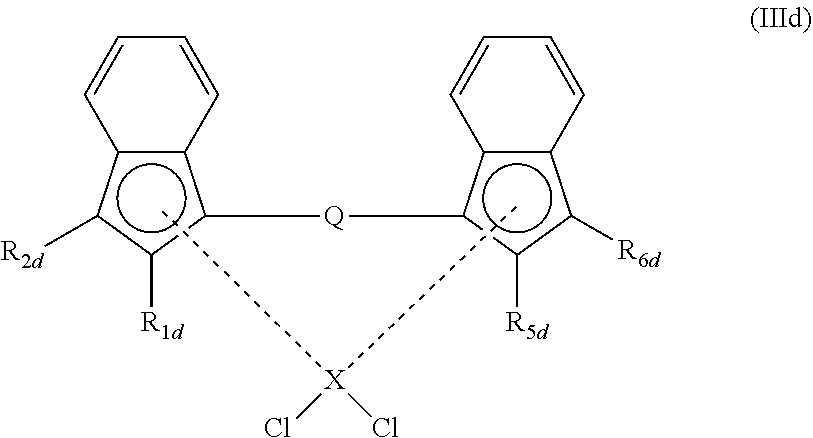
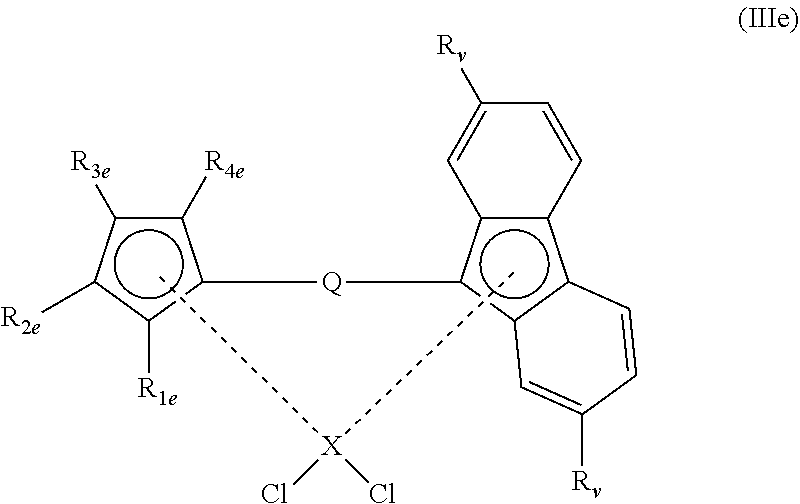
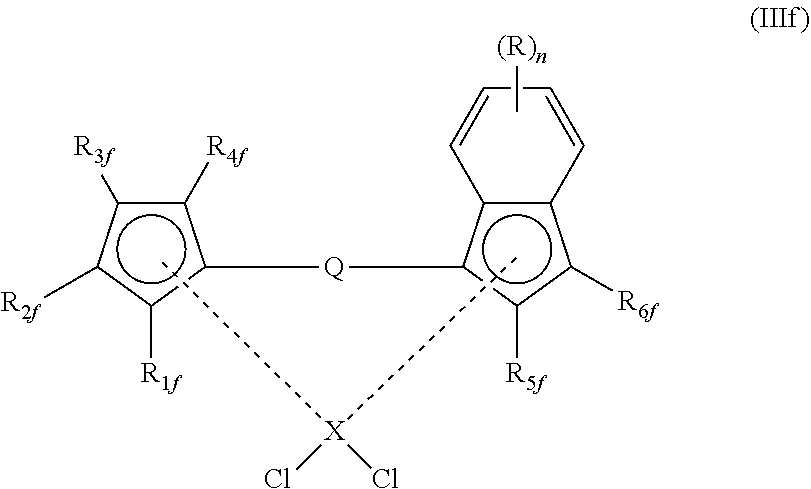

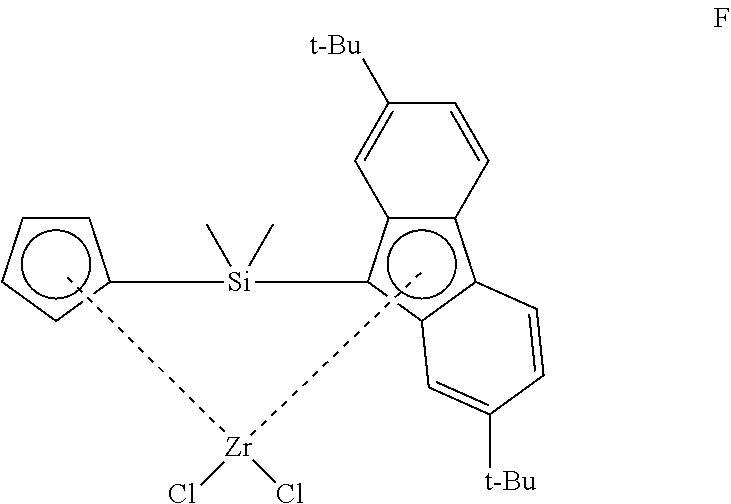



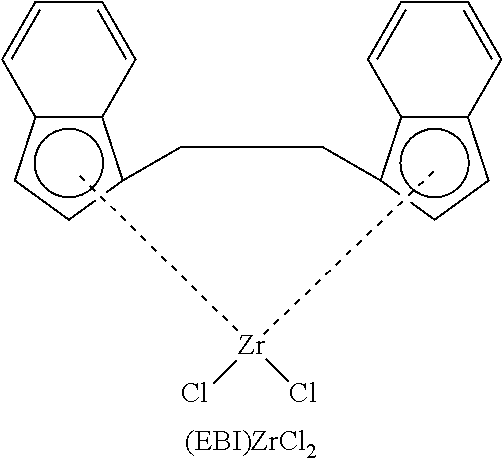
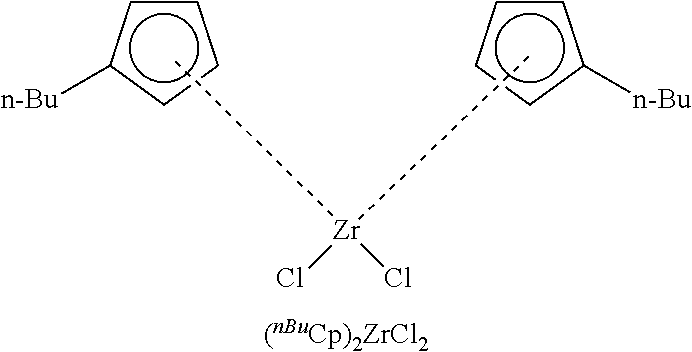

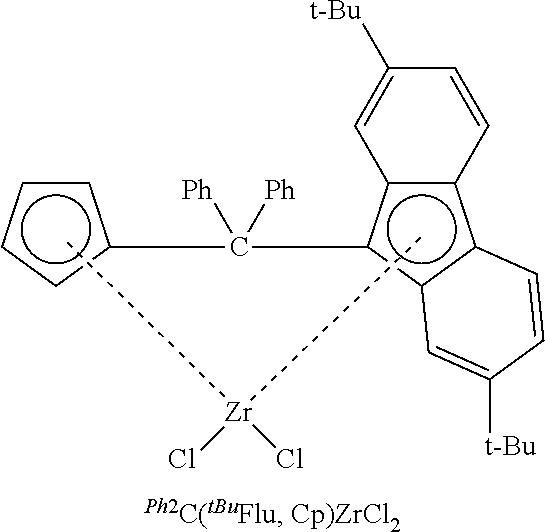
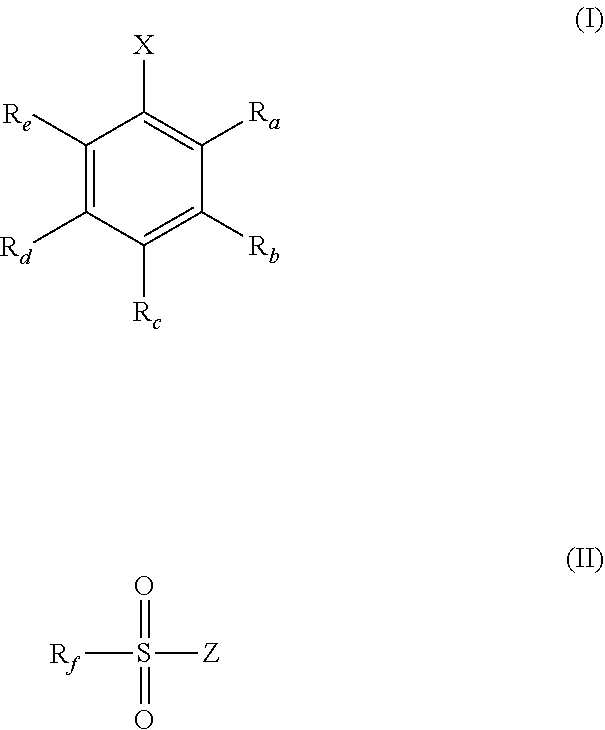


D00001
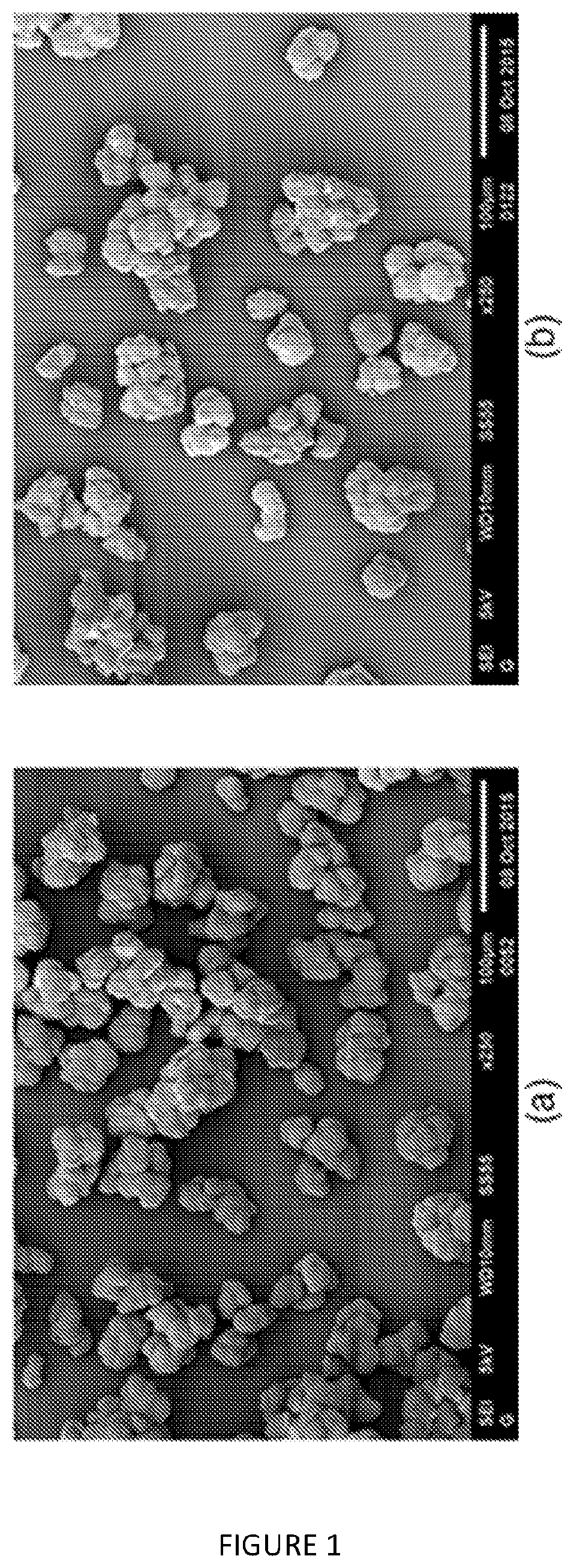
D00002

D00003
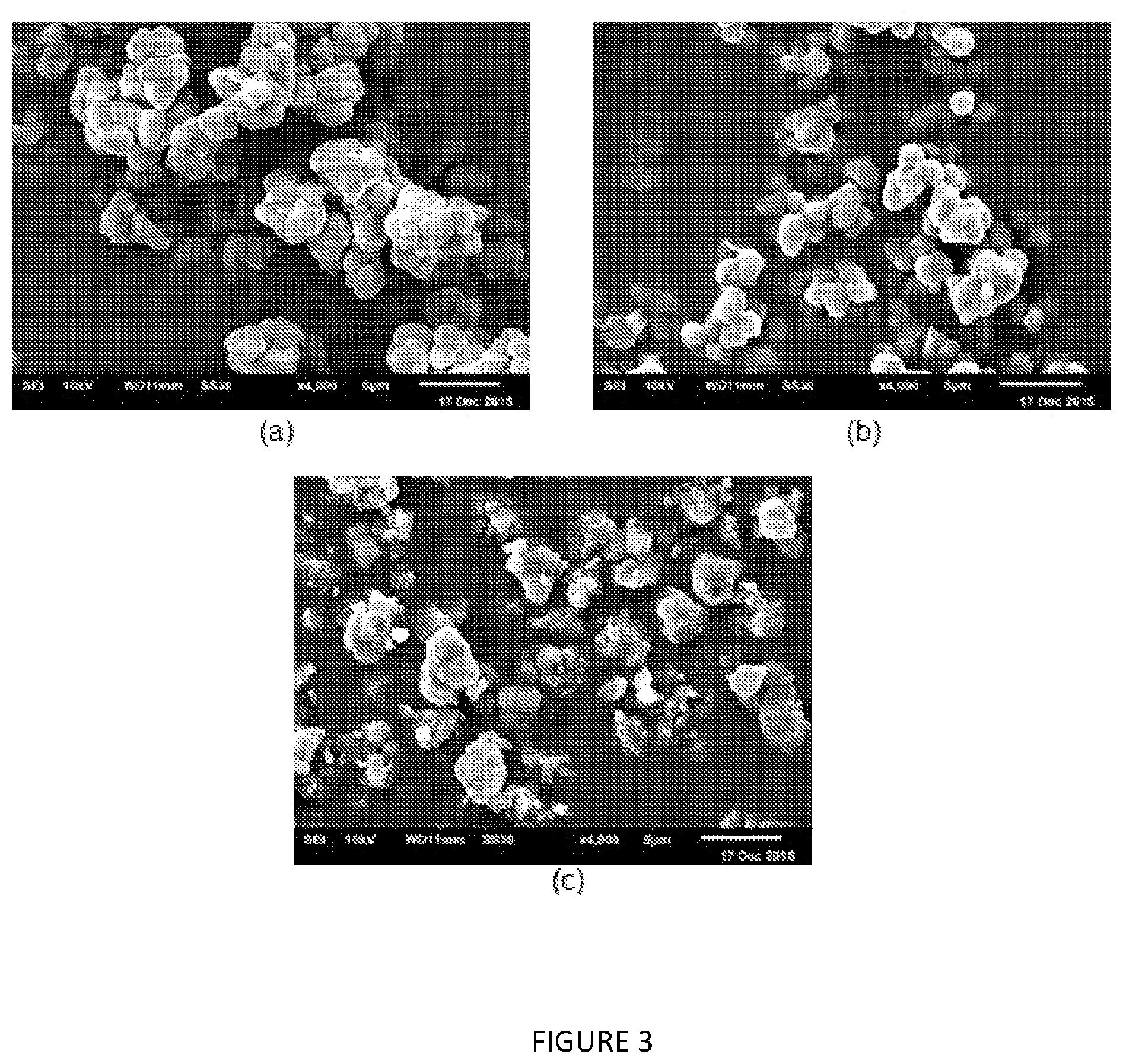
D00004

D00005
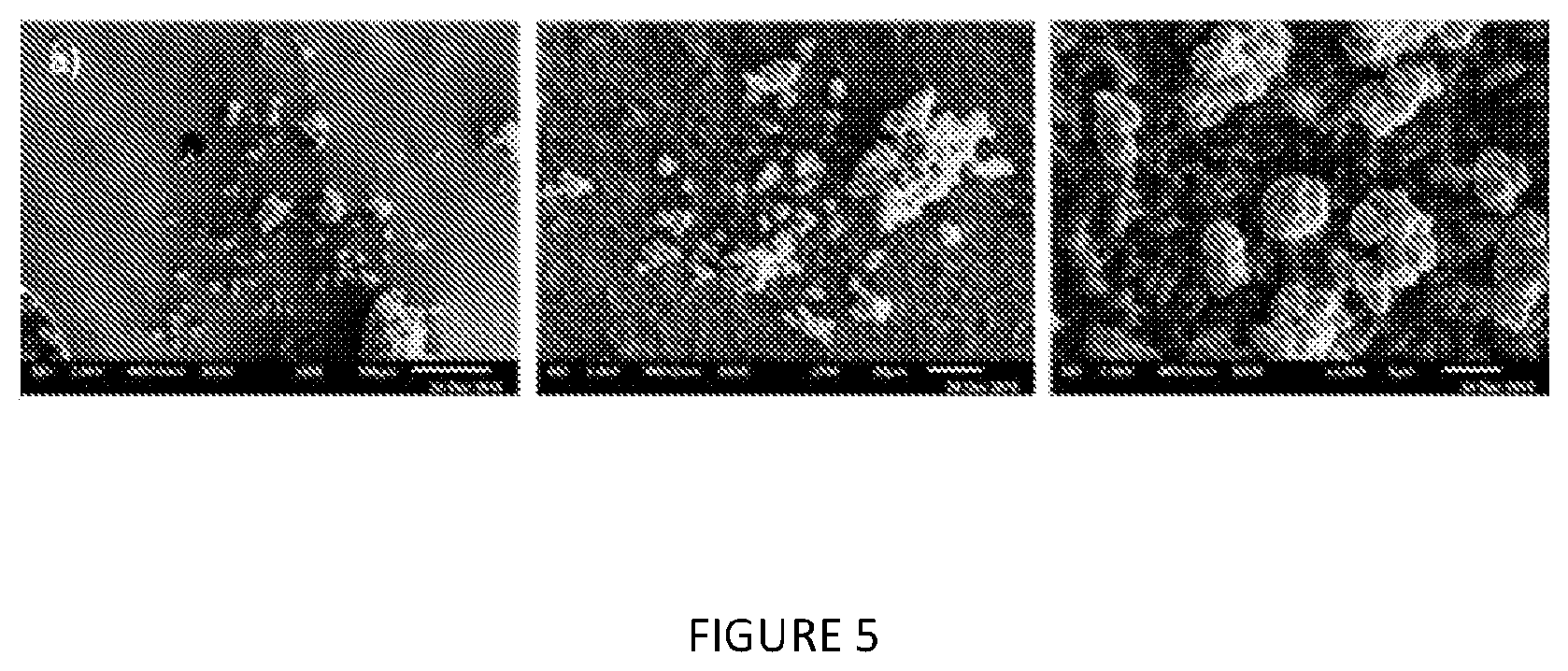
D00006
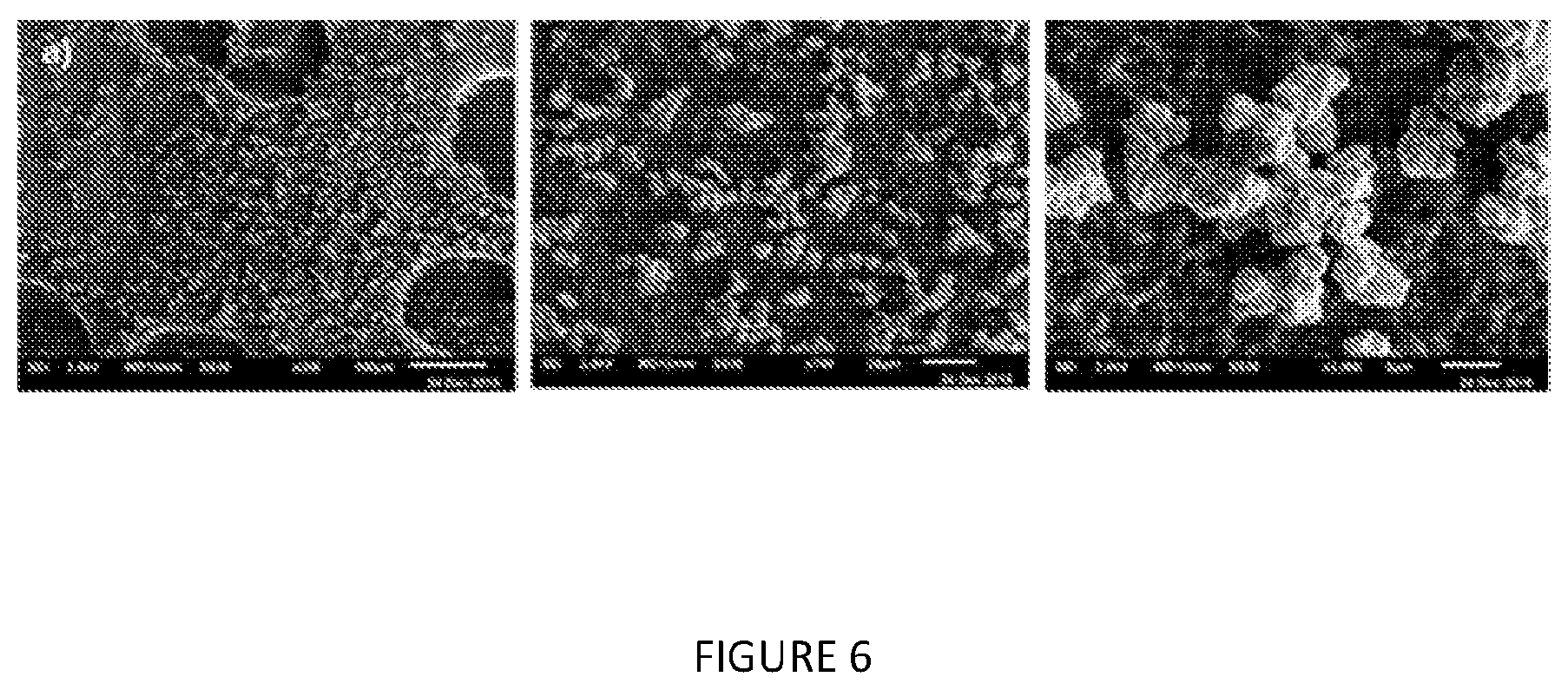
D00007
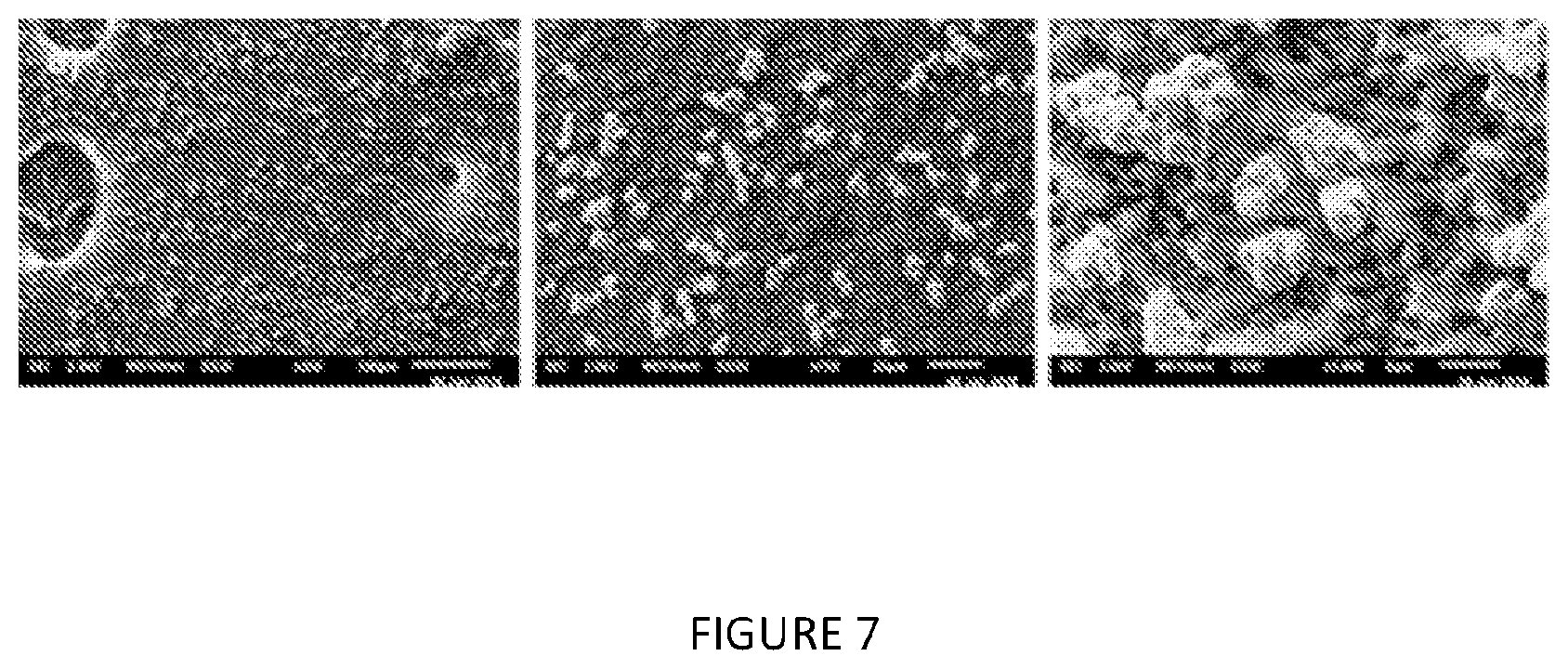
D00008
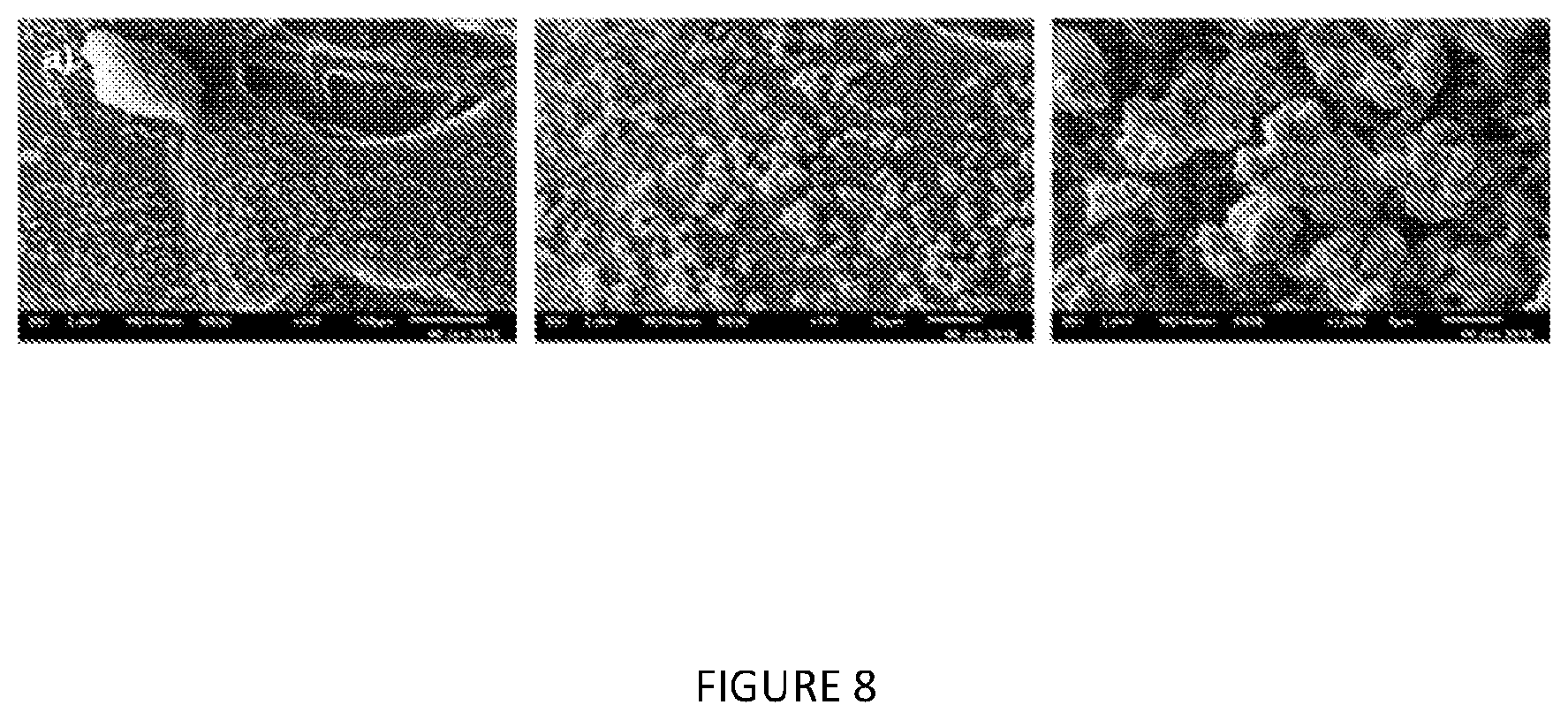
D00009

D00010

D00011

D00012

D00013

D00014

D00015

D00016
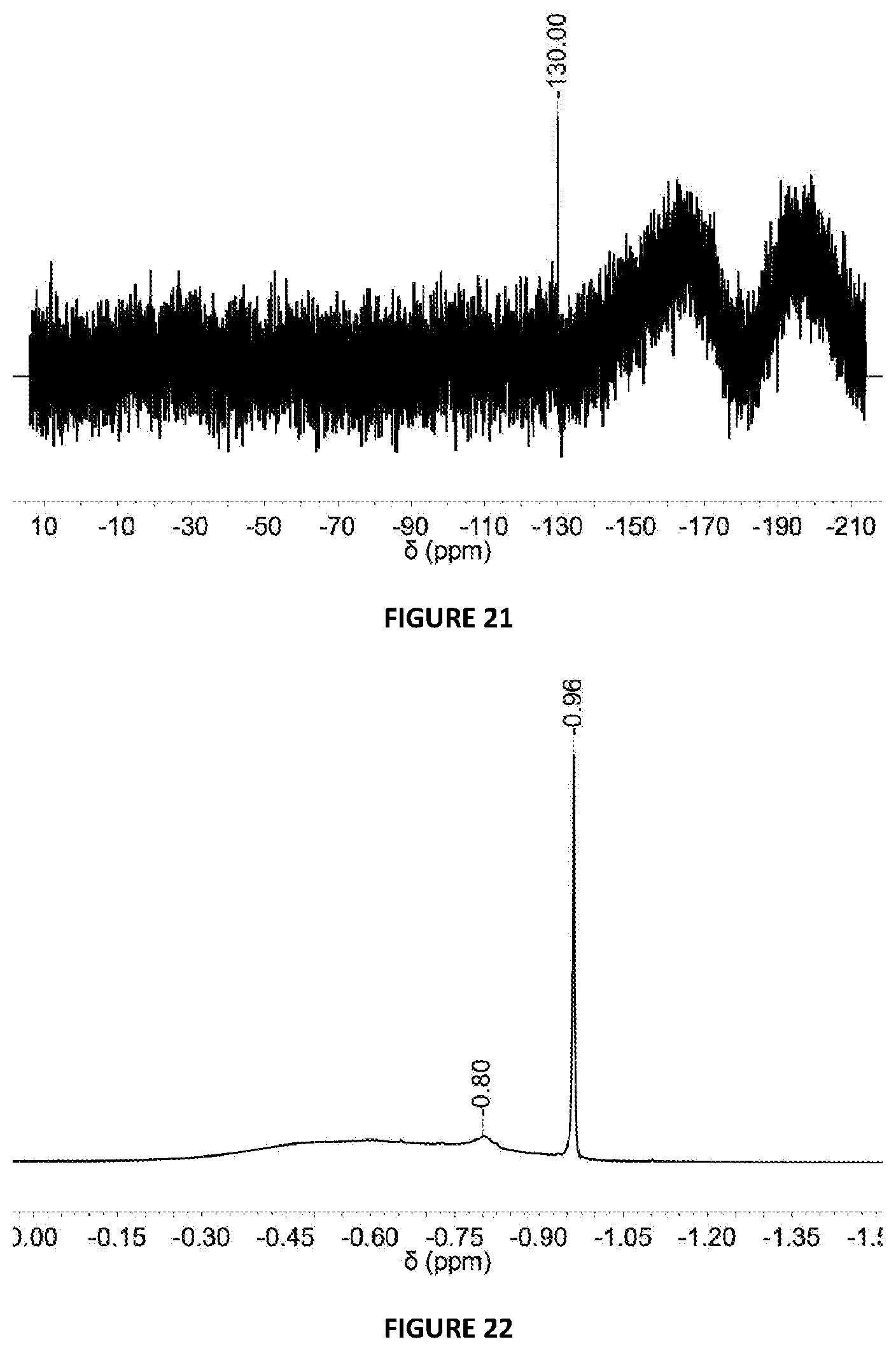
D00017

D00018

D00019
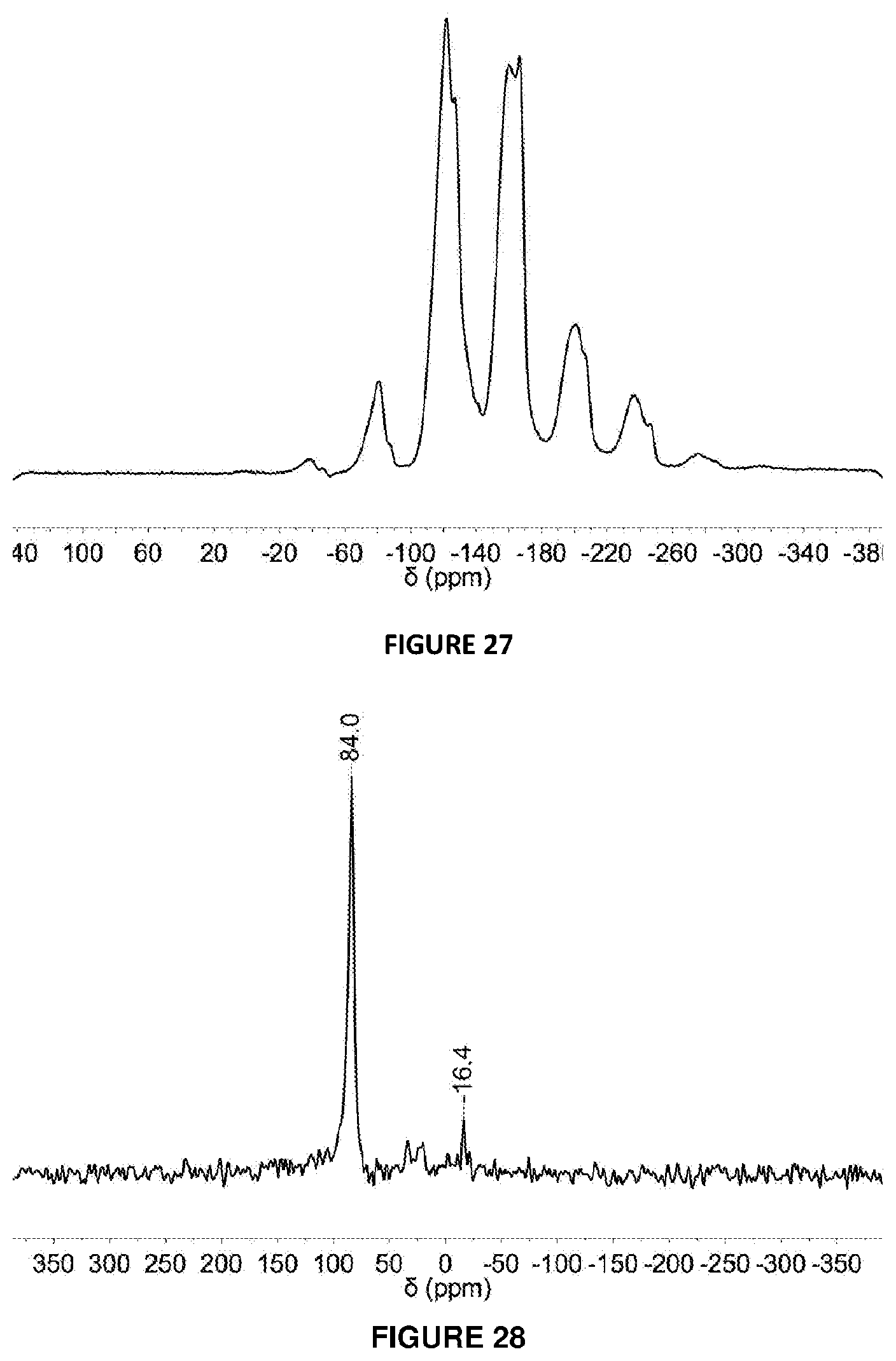
D00020

D00021

D00022

D00023
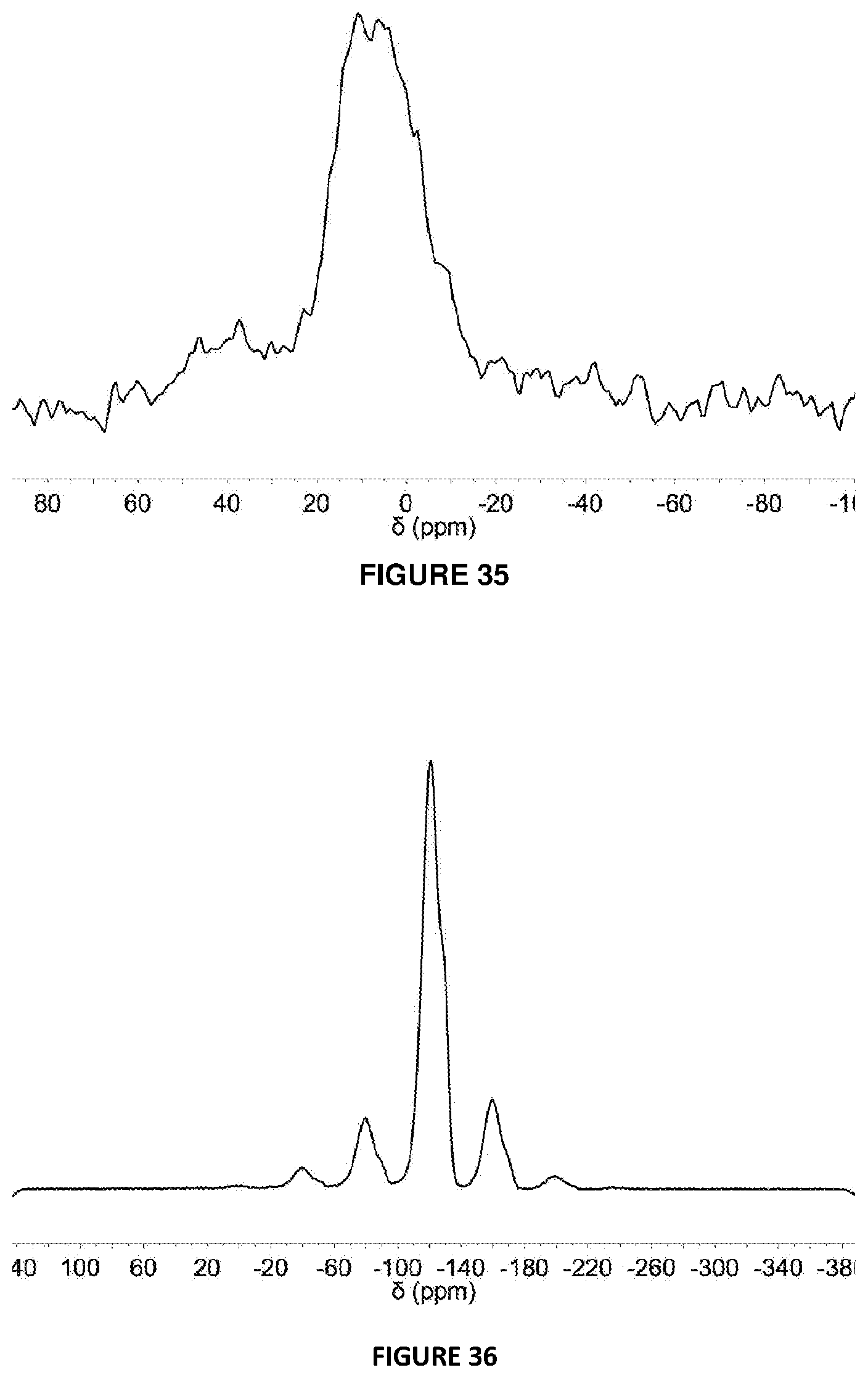
D00024
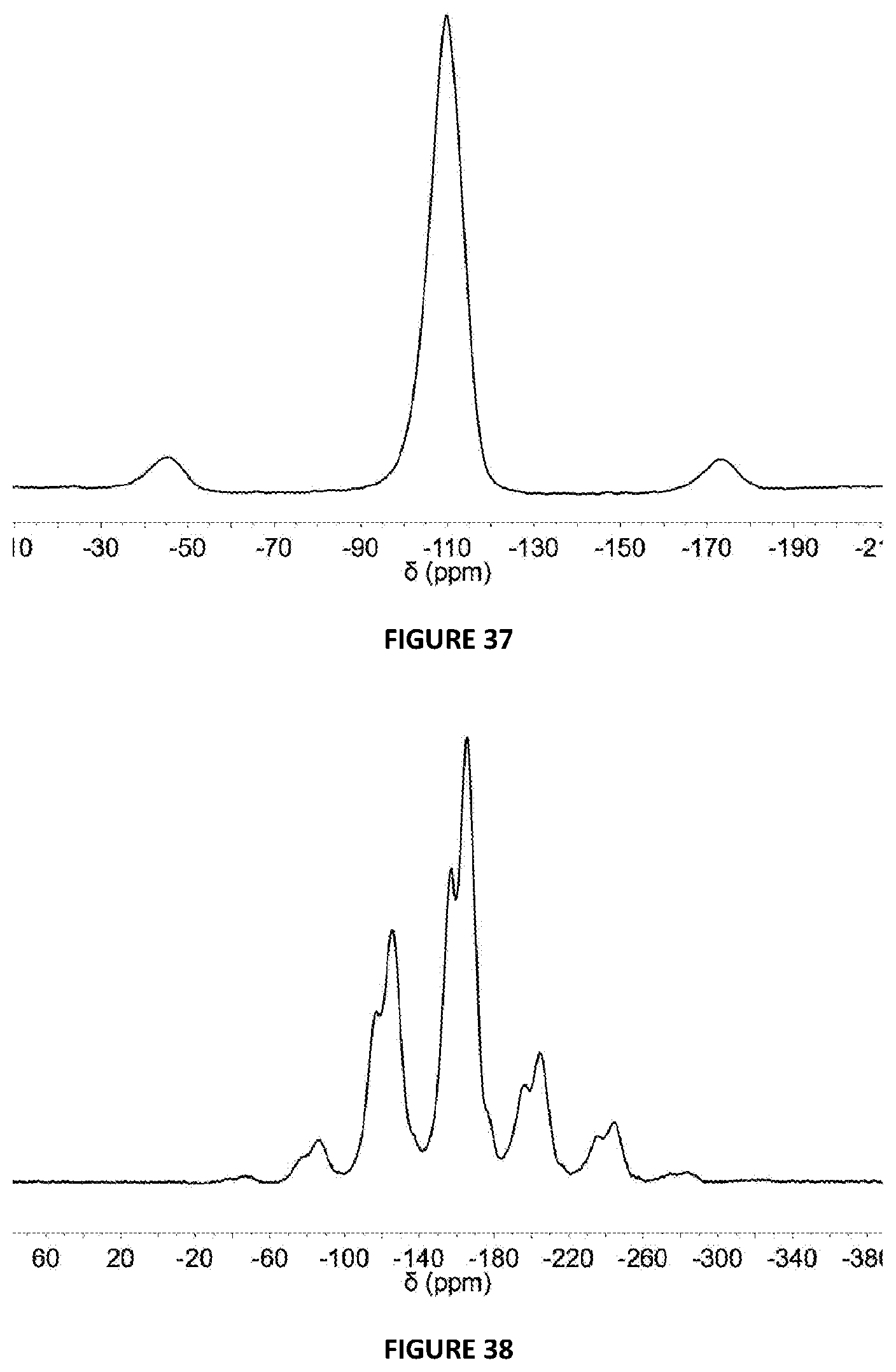
D00025
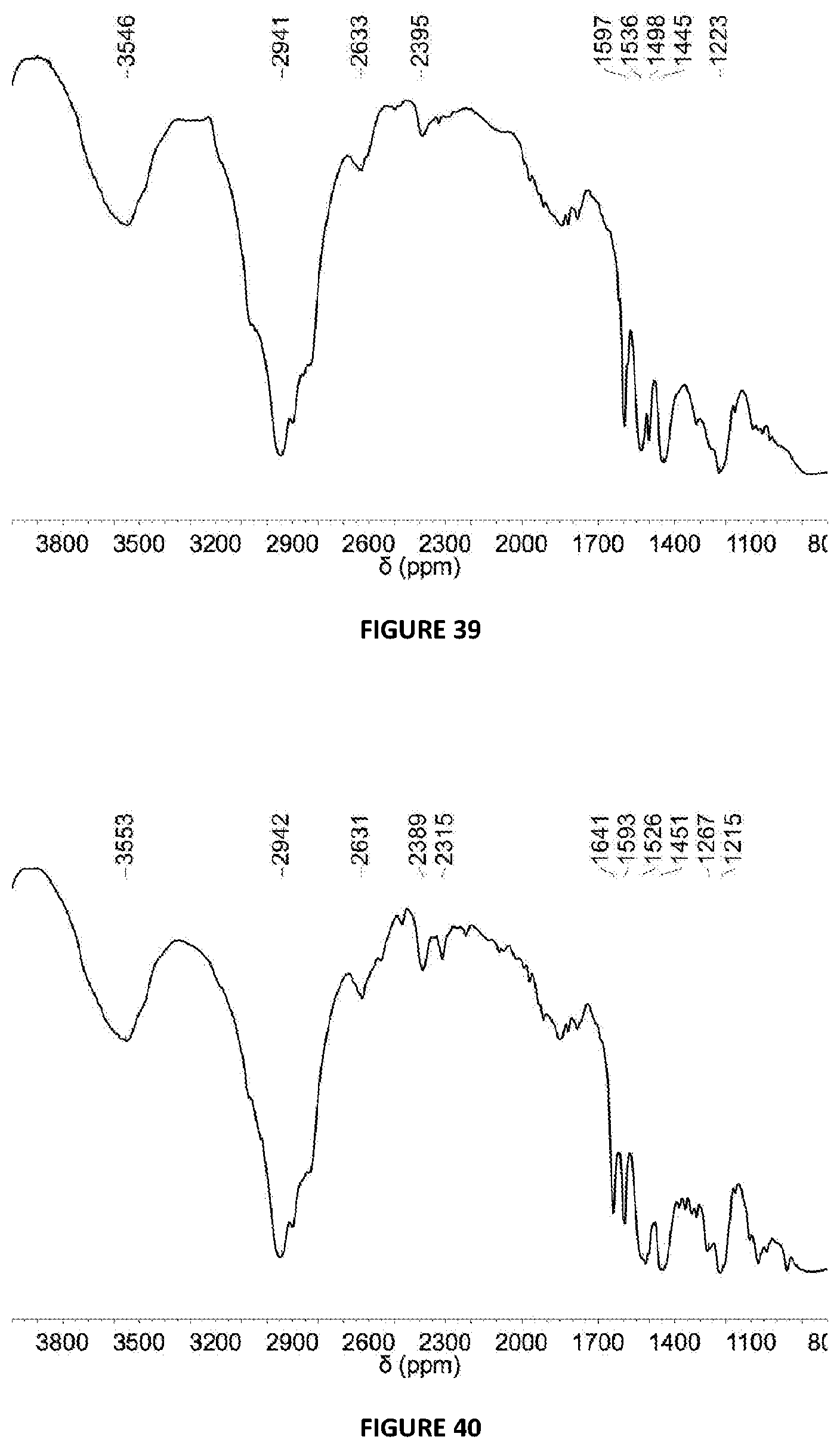
D00026

D00027
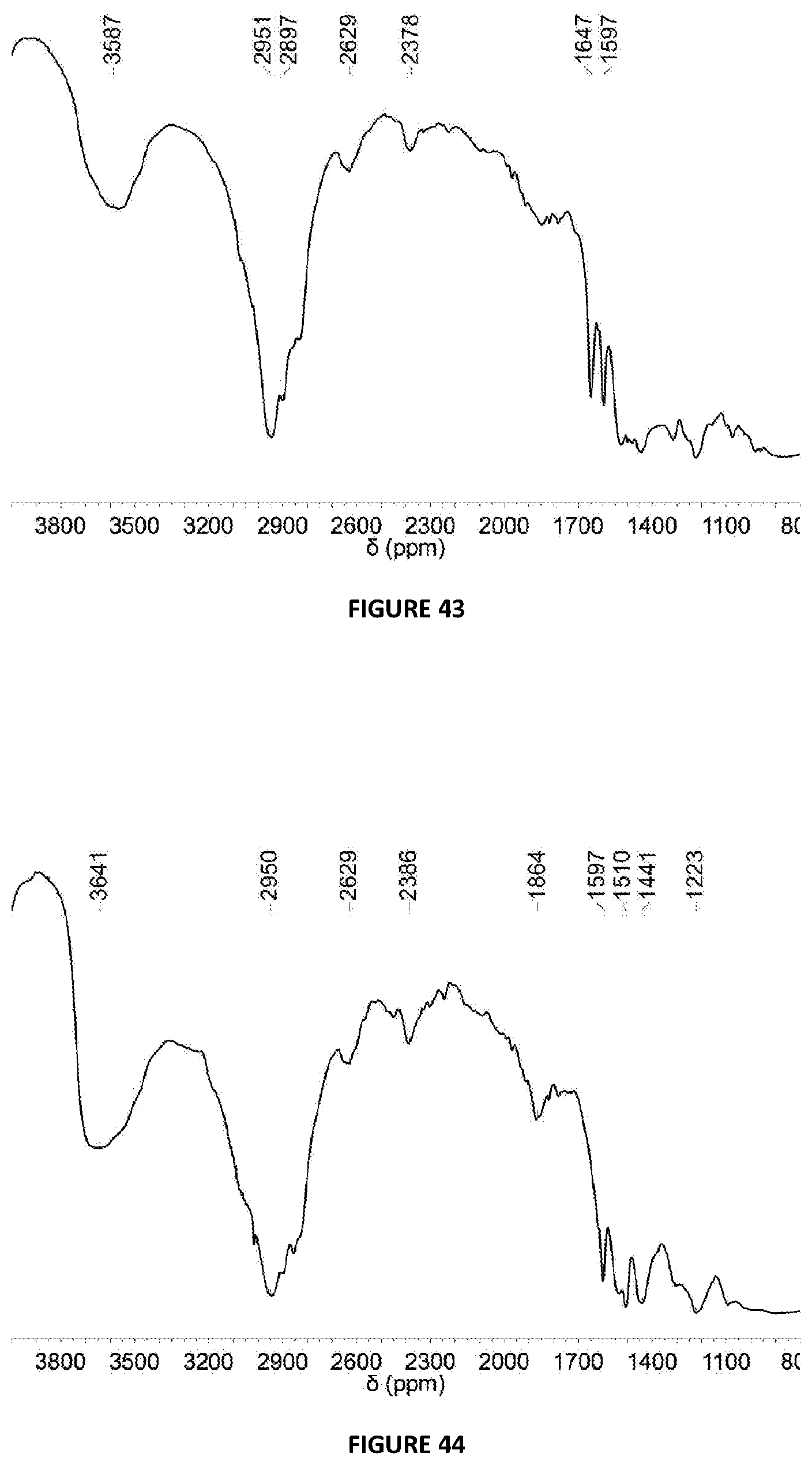
D00028
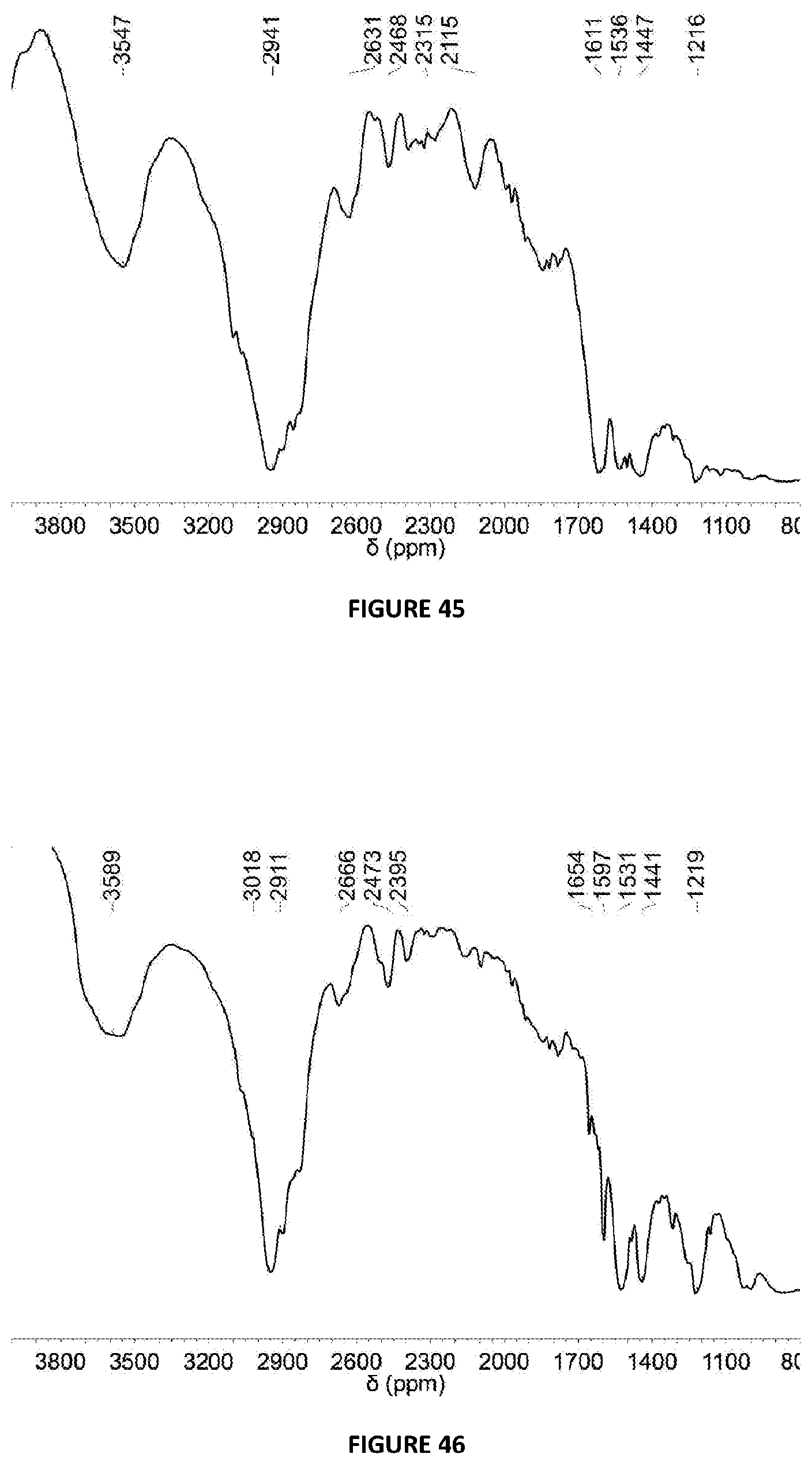
XML
uspto.report is an independent third-party trademark research tool that is not affiliated, endorsed, or sponsored by the United States Patent and Trademark Office (USPTO) or any other governmental organization. The information provided by uspto.report is based on publicly available data at the time of writing and is intended for informational purposes only.
While we strive to provide accurate and up-to-date information, we do not guarantee the accuracy, completeness, reliability, or suitability of the information displayed on this site. The use of this site is at your own risk. Any reliance you place on such information is therefore strictly at your own risk.
All official trademark data, including owner information, should be verified by visiting the official USPTO website at www.uspto.gov. This site is not intended to replace professional legal advice and should not be used as a substitute for consulting with a legal professional who is knowledgeable about trademark law.